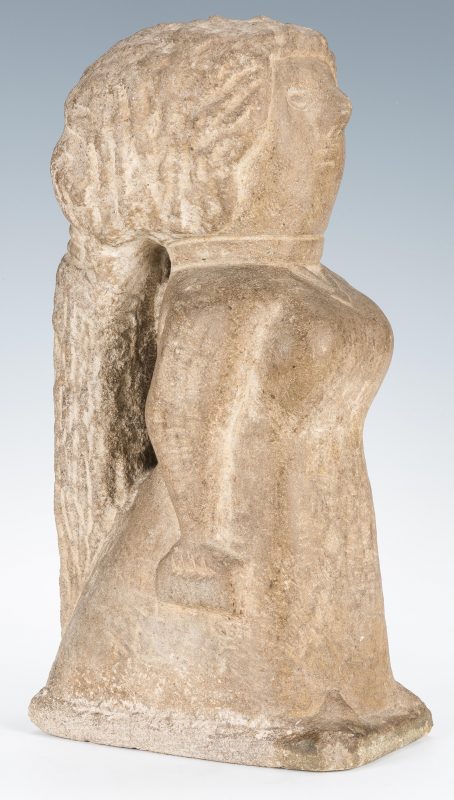 |
|
William Edmondson (American/Tennessee, 1874-1951), “Miss Lucy,” carved limestone sculpture depicting a standing woman, wearing a high collared dress and a carved locket, with long hair, holding a purse in one hand and a book, presumably The Bible, in the other. 15 1/2″ H x 4 3/4″ W x 8″ D. Circa 1930/1935. Exhibited, “Will Edmondson’s Mirkels,” the Tennessee Fine Arts Center at Cheekwood (April 12 through May 21, 1964), and listed as #6 in the catalog, published by Louise Dahl-Wolfe. Artist’s Biography: William Edmondson was born in Davidson County, Tennessee, the son of freed slaves, and worked most of his life as a railroad employee and janitor. A spiritual experience at the age of 57 prompted him to begin sculpting limestone using a railroad spike as chisel, and he claimed divine inspiration for the works produced during his 17 year art career. Women, Biblical figures and animals were among his favored subjects, although he also produced more utilitarian items such as tombstones and birdbaths. In 1937, Edmondson became the first African American artist to have a solo show at the Museum of Modern Art, and he is regarded as one of the most important self-taught artists of the 20th century.
Provenance: The estate of Janet Marsh Pruitt (Mrs. Earl Pruitt) of Pennsylvania, formerly of Nashville, Tennessee. By descent from her parents, Ross and Anna Marsh. Mrs. Marsh acquired the sculpture from a member of the Art Department, likely Professor Sidney Hirsch, while working for Peabody College in Nashville, just a few blocks from where Edmondson lived. Professor Hirsch (who frequently walked past Edmondson’s house) is credited with introducing Edmondson to well-connected arts patrons Alfred and Elizabeth Starr and Harper’s Bazaar photographer Louise Dahl-Wolfe. Wolfe’s now-famous photographs of Edmondson and his yard full of limestone sculptures brought him to the attention of the New York art world and gained him the acquaintance of Alfred Barr, Jr., director of the Museum of Modern Art. Unlike many Edmondson figures acquired by Nashvillians in the days before Edmondson gained international fame, “Miss Lucy” was not kept outside as garden sculpture. Mrs. Marsh told her family the limestone figure was always used inside as a doorstop (which has helped the sculpture avoid surface bleaching and erosion). According to the exhibit catalog, which quoted the Marshes, “Miss Lucy” was a good member of Edmondson’s church who had been “uplifted to heaven.” |
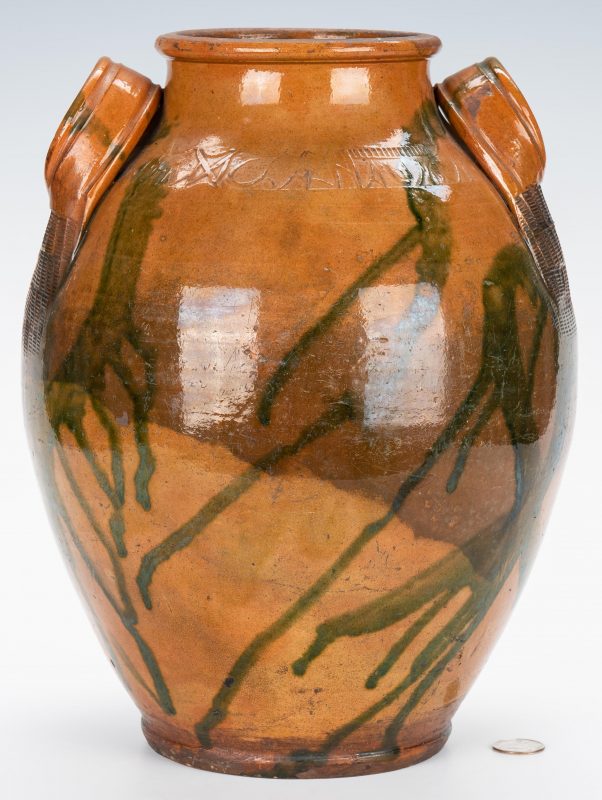 |
|
Christopher Alexander Haun (Greene County, TN, 1821-1861) lead and copper oxide decorated earthenware jar. Coggled band on upper shoulder “C A Haun No. 1” and elaborate tread stamp designs at the base of the handles. More information in the coming weeks. |
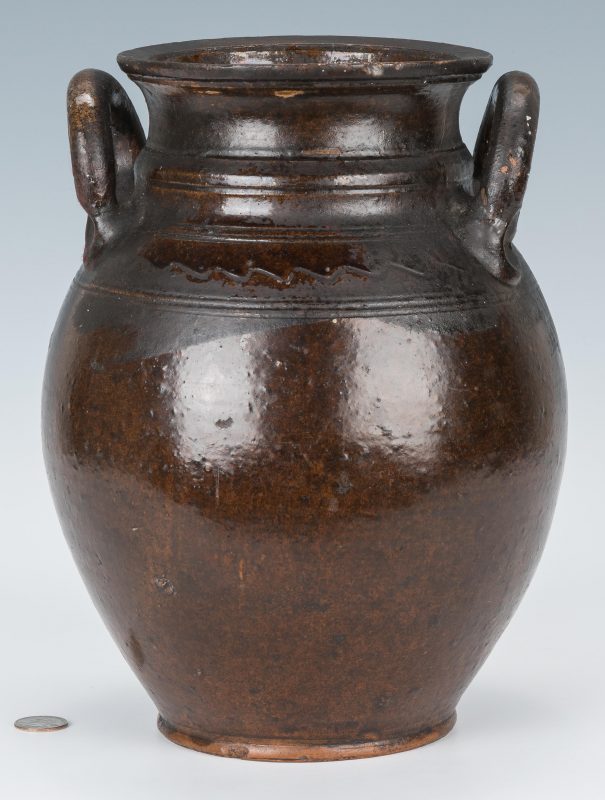 |
|
Southwest Virginia earthenware jar with rolled open-loop lug handles, flaring rim, and sine wave incising around the shoulder bordered by two incised lines. Base with beaded foot, unglazed on the bottom. Height 12″. Found in Grayson Co., Virginia. Second quarter of the 19th century. |
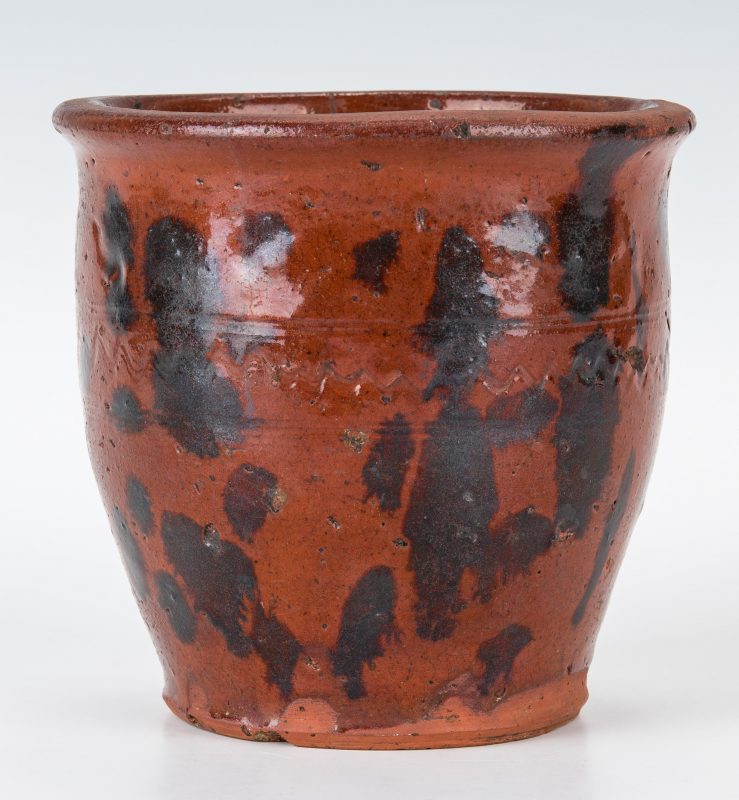 |
|
East Tennessee lead-glazed earthenware cream pot with combed sine wave bordered by incised lines, manganese “splotched” decoration on outside and inside of the cream pot, attributed to the Cain Pottery, Sullivan County. 4 1/2″ H. 2nd Quarter 19th century. Note: This jar was exhibited in the “Legacy in Clay: Pottery of Washington County, Virginia” 2005 exhibit, William King Regional Arts Center, Abingdon, VA. The jar is also illustrated in the “Legacy in Clay” museum exhibit catalog, page 8. Note: recognition of the prolific Cain pottery in East Tennessee was noted in published resources as early as 1909, where in the publication “Historic Sullivan,” Oliver Taylor states “Another factory which received national attention was the Cain pottery, located at Emanuel Church, and owned by two brothers, William M. and Abe Cain . . . It was operated about 1840 and, among other wares, souvenir jugs were made, many of which are still in existence.” (Research courtesy of Dr. Carole Wahler). |
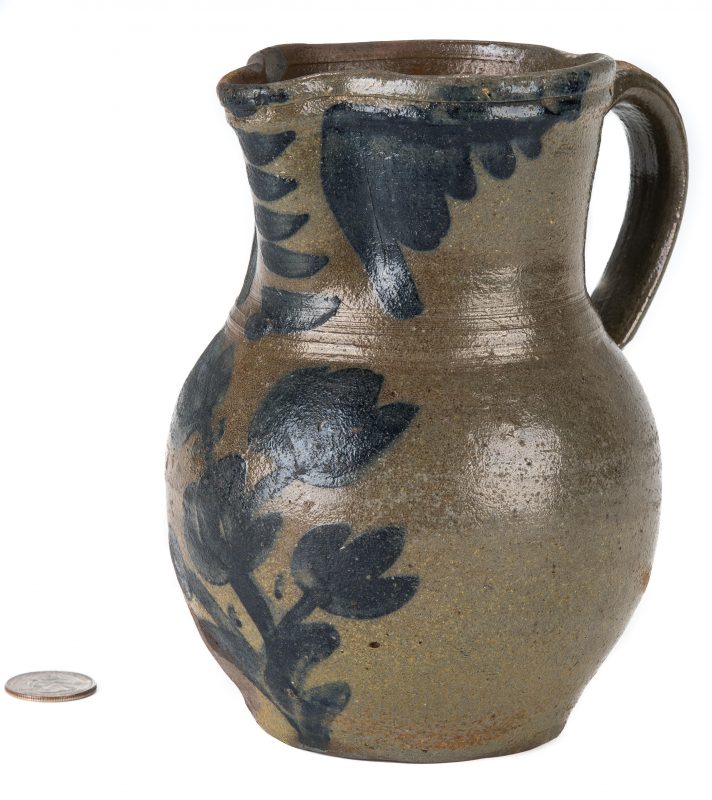 |
|
Small Washington County, Virginia salt-glazed stoneware pitcher with elaborate cobalt floral decoration to the body and cobalt decoration to the spout and neck. 6 3/4″ H x 4″ diameter. 2nd half of the 19th century. Note: This pitcher was exhibited in the “Legacy in Clay: Pottery of Washington County, Virginia” 2005 exhibit, William King Regional Arts Center, Abingdon, VA. It was also illustrated in the “Legacy in Clay” museum exhibit catalog and in the book “Great Road Style: The Decorative Arts Legacy of Southwest Virginia & Northeast Tennessee”, Betsy K. White, University of Virginia, page 147, figure 134.
|
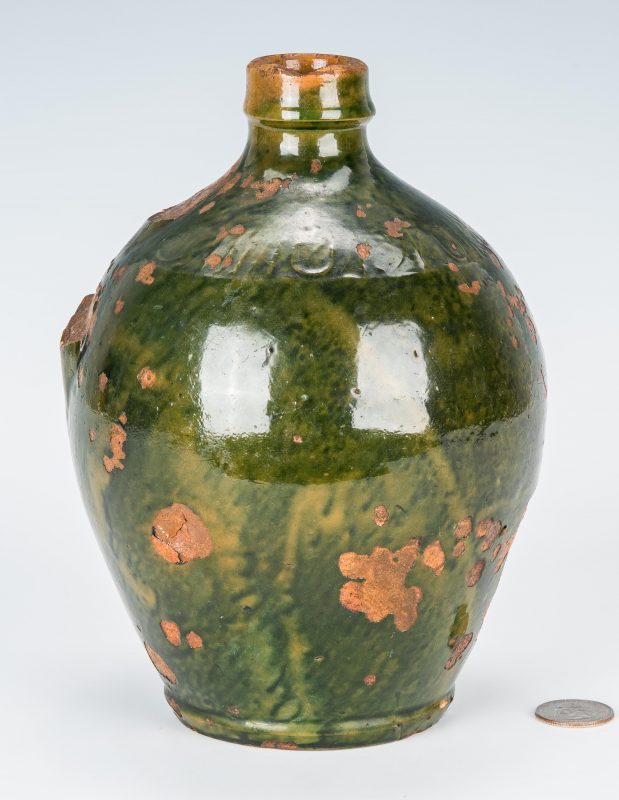 |
|
East Tennessee, Greene County, earthenware pottery jug by Christopher Alexander Haun (1821-1861), Greene County, Tennessee. This is the only known marked jug example, with one row of stamping on the the shoulder including the letters “C A Haun” and star or sunburst stamp, with a green copper oxide glaze. 8 1/4″ H. Note – Haun was a Union sympathizer during the Civil War and participated in burning a Confederate railroad bridge (Lick Creek) in Greene County, TN. This important event in East Tennessee’s Civil War history was initiated with a campaign by Union loyalists to burn 9 bridges. It was led by William B. Carter and strongly supported and encouraged by President Abraham Lincoln. Several potters from the Pottertown, TN area were among the men who conspired and succeeded in burning the bridge. The potters decided not to capture or kill the Confederate bridge guards but allowed them to go free based upon their solemn promises to not reveal their identities. Union troops did not materialize as promised, and the Confederates were able to pursue and capture some of the perpetrators. The Confederate guards, who were allowed to live, were the very ones who served as witnesses to implicate the five men who were hung, four of them potters. Among those sentenced to hang was the potter Christopher Alexander Haun. On December 11th, 1861, Haun was hung from the gallows in Knoxville, TN. |
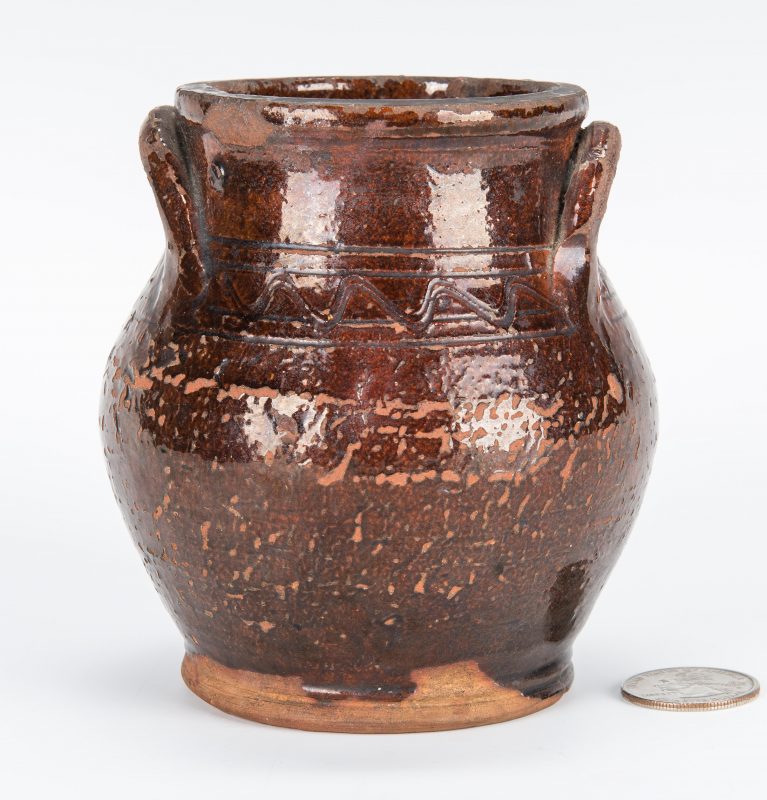 |
|
Southwest Virginia or East Tennessee miniature lead-glazed earthenware jar, with banded sine wave decoration to the upper shoulder and rolled applied handles. Possibly Cain pottery of Sullivan Co., TN. Featured in the “Legacy in Clay: The Pottery of Washington County, Jul 22-Nov 20, 2005” exhibition catalog and exhibited at the William King Regional Arts Center, Abingdon, Virginia. 4 1/4″H. Third quarter of the 19th century. |
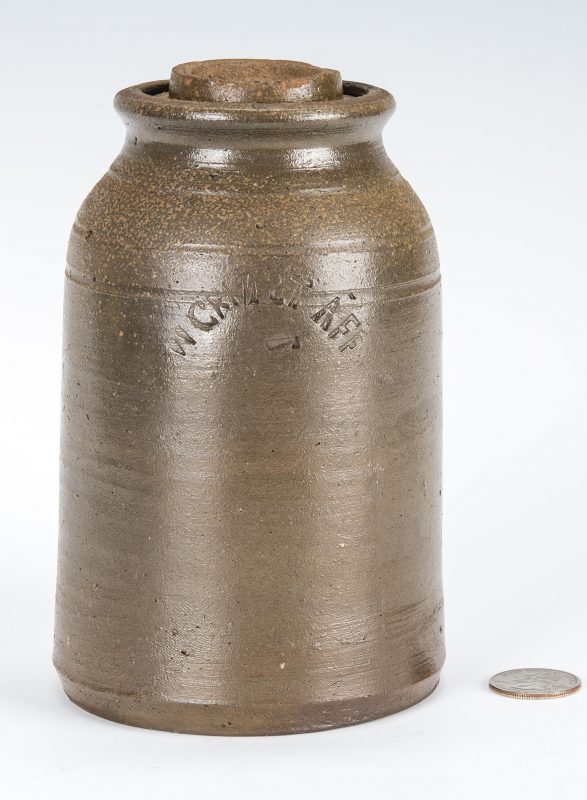 |
|
East Tennessee, possibly Knox County, salt glazed stoneware lidded jar having three incised lines around the shoulder. Upper body with impressed semi-circle stamp “W. Grinstaff” for William Grindstaff, with a sideways “1” underneath. The “S” is backwards. 6 1/4″ H with lid. Late 19th century. Note: This jar was featured in the 1996 “Tennessee Turned: Earthenware and Stoneware Made in East Tennessee 1800-1900” exhibition at the East Tennessee Historical Society in Knoxville, TN. Carole Wahler, exhibition curator. |
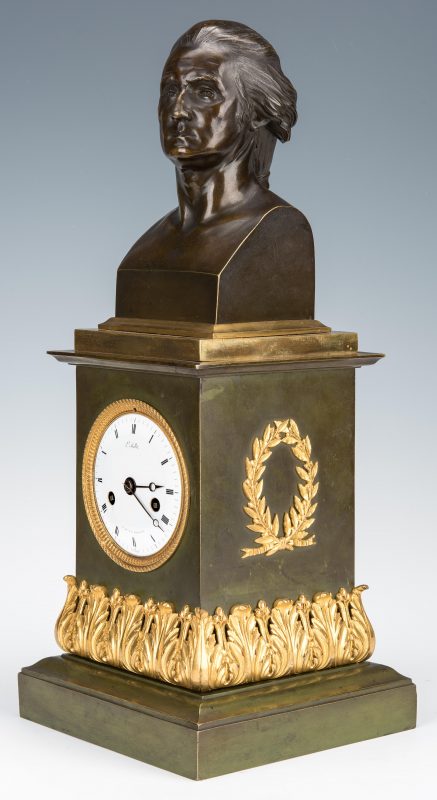 |
|
Classical gilt and patinated bronze mantel clock by Louis Mallet (French, 1820-1830). Comprised of a plinth form base with gilt acanthus leaf and laurel wreath mounts, enamel dial having a gilt bezel with Roman numeral chapter ring and signed “Ls. Mallet/ H. de M.D. D’Orleans/No. 1078″, all surmounted by a patinated bronze bust of George Washington. 18 1/2″H x 7 5/8” W x 7 5/8″D. |
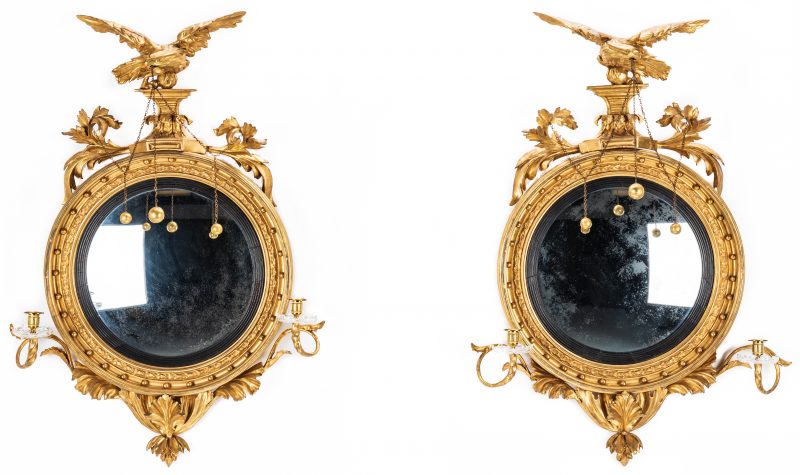 |
|
Scarce pair of American Federal Period Girandole mirrors, each surmounted by a carved gilt eagle on plinth flanked by acanthus leaves, giltwood balls on metal chains suspended from the eagle’s mouth, two candle arms issuing from acanthus leaves at the lowermost edge of the mirror, with gilt bronze candle cups and cut crystal bobeches, approx. 40″ x 27″ x 10″. Early 19th century. More information in the coming weeks. |
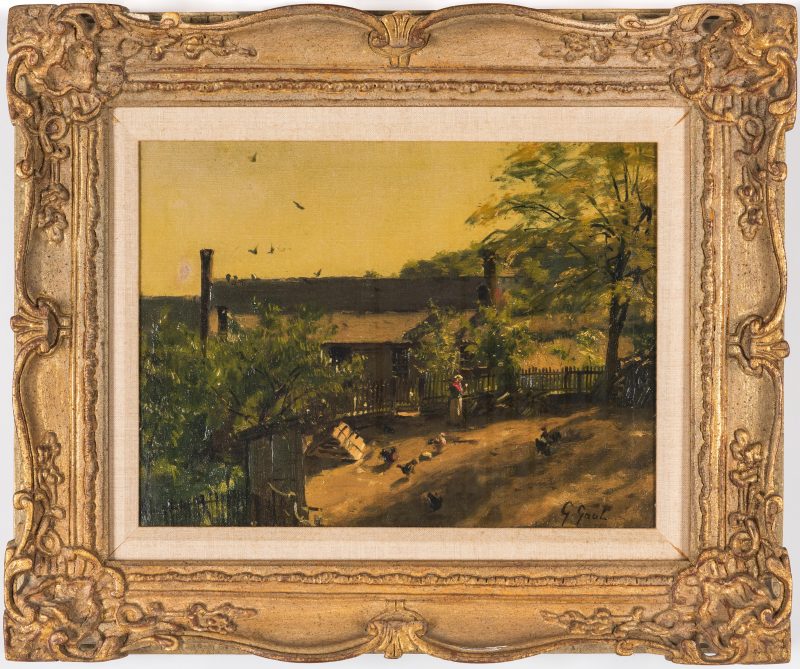 |
|
Gilbert Gaul (New York/Tennessee/New Jersey, 1855-1919) oil on board landscape painting, depicting a woman standing in a Tennessee farmyard with chickens at her feet, a cottage in the background. Signed lower right. Exhibited under the title “Untitled (Tennessee Farmyard)” at the Tennessee State Museum, November 22, 1992 to February 28, 1993, “Gilbert Gaul: American Realist” and featured in the exhibition catalog on page 16. Carved giltwood frame with linen liner. 11 1/2″ x 15 1/2″ sight, 20″ x 23 1/2″ framed. Provenance: the estate of Delle Brown, Nashville, TN. |
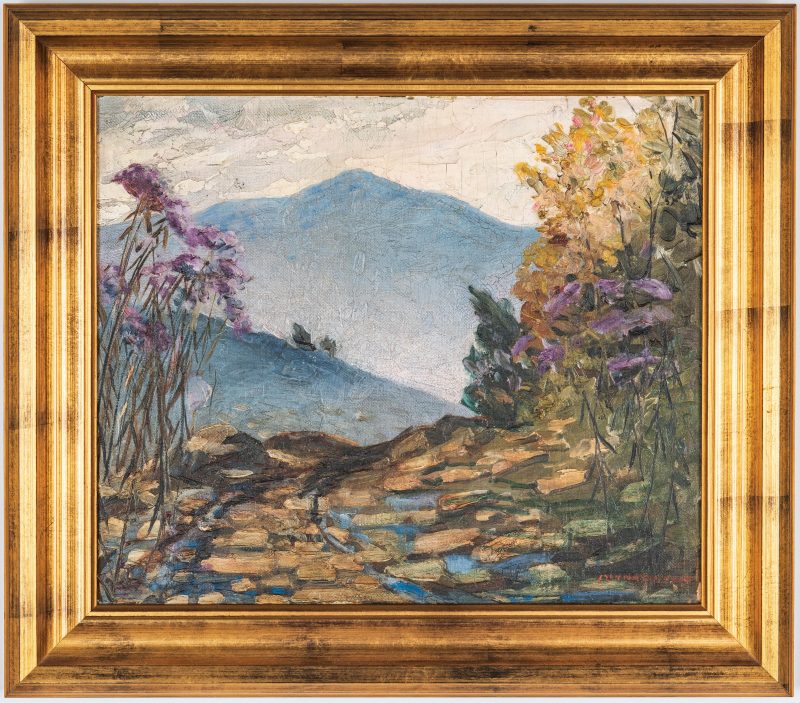 |
|
Mayna Treanor Avent (Tennessee, 1865-1959) Impressionist oil on canvas laid to board, Great Smoky mountain landscape, depicting a wildflower lined path leading to mountains in the background. Signed lower right “Mayna T Avent”. Wide molded giltwood frame with Lyzon framing label en verso. 15 1/2″ x 18 1/2″ sight, 21″ x 24″ framed. Biography: Mayna Treanor Avent was born at Tulip Grove Mansion (across from the Hermitage), studied in Cincinnati and at the Julian Academy in Paris. Her work is in the collection of the Smithsonian Institute’s National Portrait Gallery, The White House, and The Tennessee State Museum, Nashville. Her cabin studio was in the Great Smoky Mountains National Park and is listed on the National Register of Historic Places. Source: James C. Kelley, “The South on Paper: Line, Color and Light” and The Tennessee Historical Quarterly, Winter 1987. |
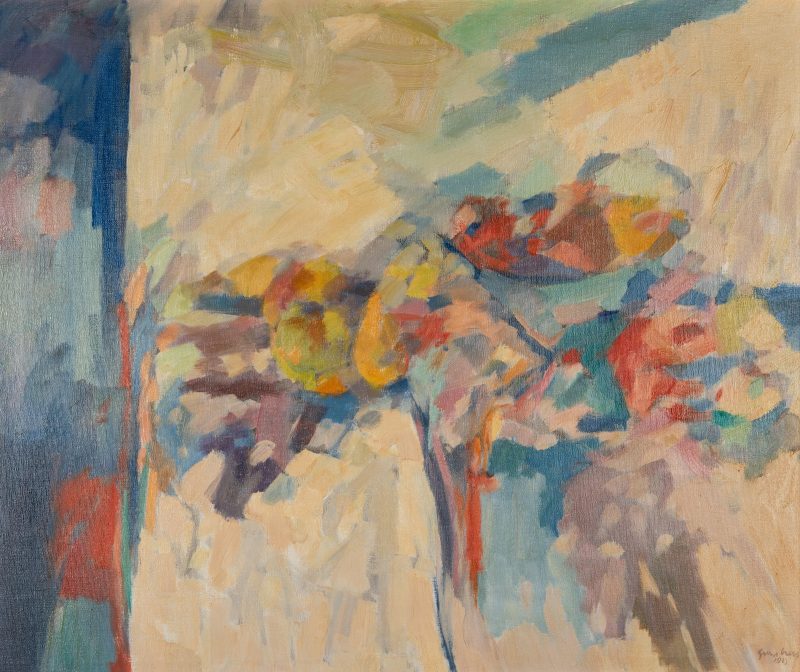 |
|
George Ayers Cress (Alabama/Tennessee, 1921-2008) oil on canvas abstract still life painting. 28 1/2″ H x 35″ W. Frame 34 1/4″ H x 40″ W. More information in the coming weeks. |
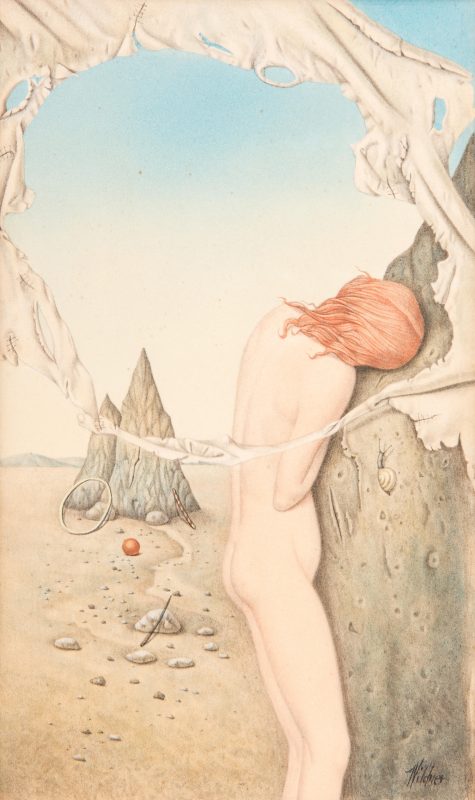 |
|
Werner Wildner (Nashville, Tennessee, 1925-2004) oil on board depicting a nude woman hiding her face against a rock in a surrealist landscape. Signed “Wildner” lower right. Sight – 9 1/2″ H x 5 3/4″ W. Framed – 12 7/8″ H x 9 1/4″ W. More information in the coming weeks. |
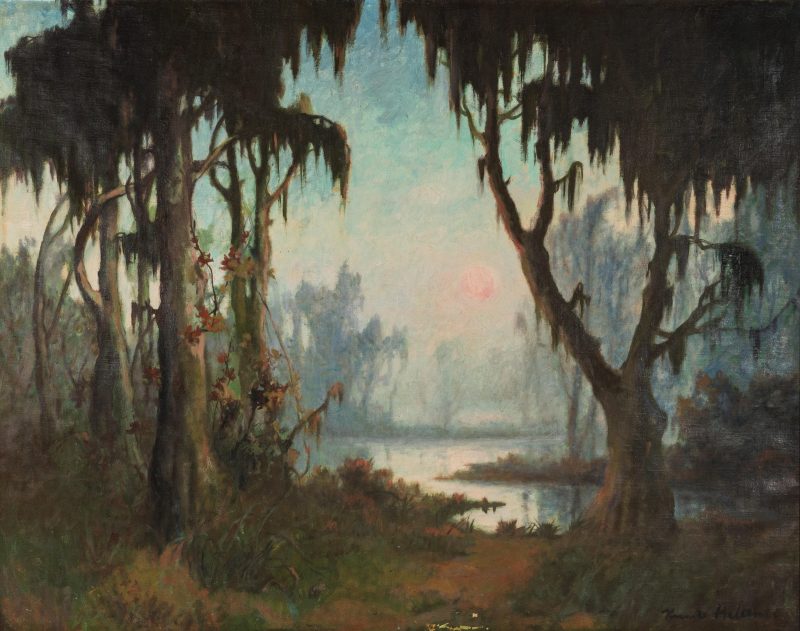 |
|
Large Knute Heldner (1877-1952, Louisiana/Minnesota/Sweden) oil on canvas Louisiana bayou landscape, depicting a body of water surrounded by moss-draped live oaks, under a red setting sun. Signed lower right, “Knute Heldner”. Housed in a Rococo style giltwood frame with beaded rabbet edge and openwork scroll moldings at outer edges. 33 1/2″ x 42″ sight, 43 1/2″ x 51 1/2″ framed. Provenance: The estate of Hill Todd, Nashville, Tennessee. |
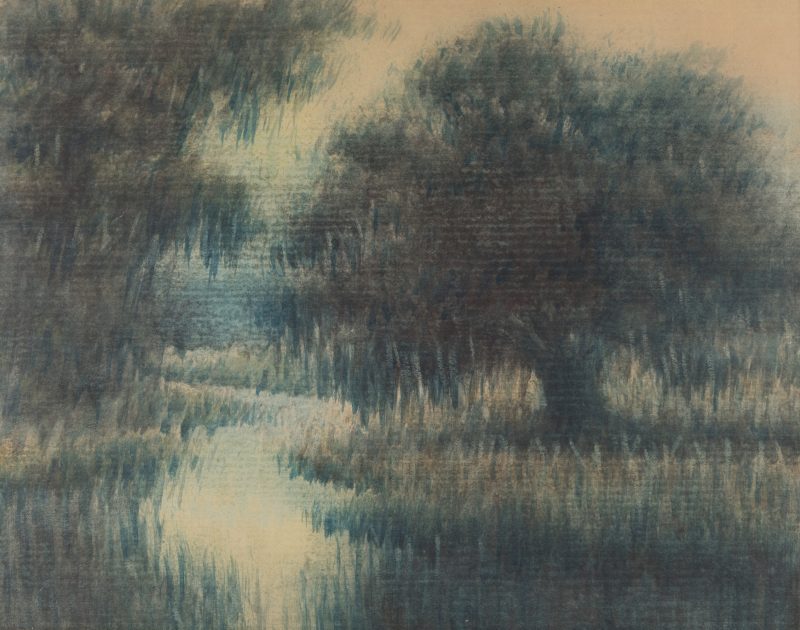 |
|
Alexander John Drysdale (American/Louisiana, 1870-1934) oil wash on paper of a Louisiana Bayou landscape. Signed faintly “A. Drysdale” lower right. Framed under glass with taupe double mats and a later giltwood molded frame. 14 3/4″ x 19″ sight, 22 1/2″ x 26 1/2″ framed. American, early 20th century. |
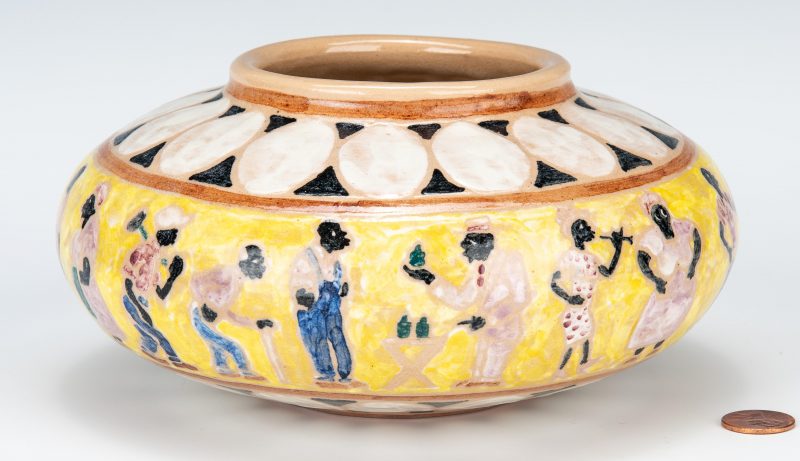 |
|
Shearwater Art Pottery low jar, by James MCConnell “Mac” Anderson (1907-1998, Mississippi) glazed in colors of yellow, white, black pink, blue and brown with a central frieze or band of African Americans to the center of the body. Signed and dated “79 on the base along with the impressed semi-circular “Shearwater” mark . 4″ H x 7 1/2″ Diameter. |
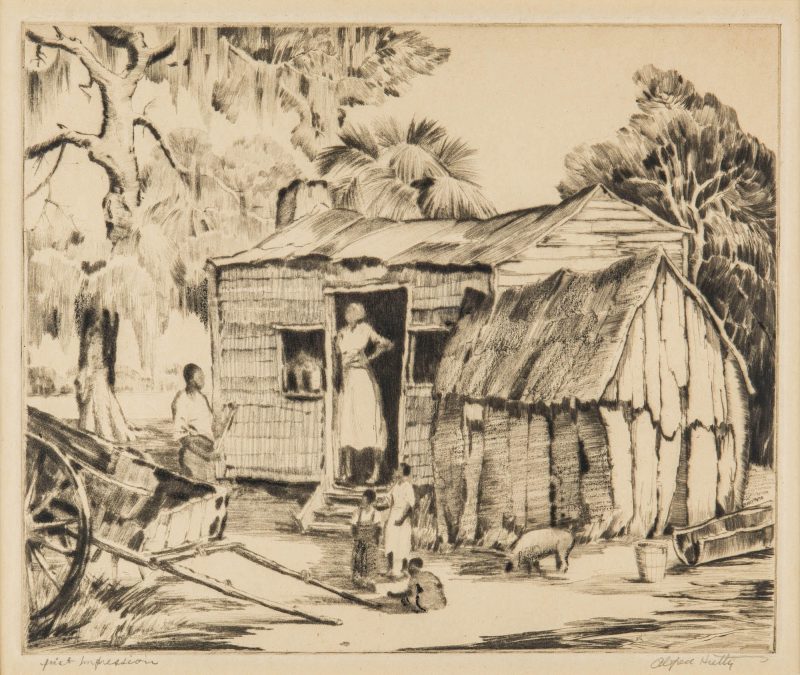 |
|
Alfred Heber Hutty (Charleston, South Carolina, 1877-1954), drypoint etching, “A Southern Villa, No. 1,” view of a Carolina cabin with woman standing in the doorway, with children, a pig, and man standing beside a wagon frame in the yard. Signed “Alfred Hutty” lower right and “First Impression” lower left margin. Circa 1948, edition of 75. Note: other copies of this print are the collections of the Gibbes Museum and the Morris Museum of Art. Ivory mat and stained wood frame. Carolina Galleries label en verso. Plate size 9″ x 10 5/8″, sight 9 3/4″ x 11 3/8″, framed 16 3/4 x 20 3/4. Private Middle Tennessee Collection. |
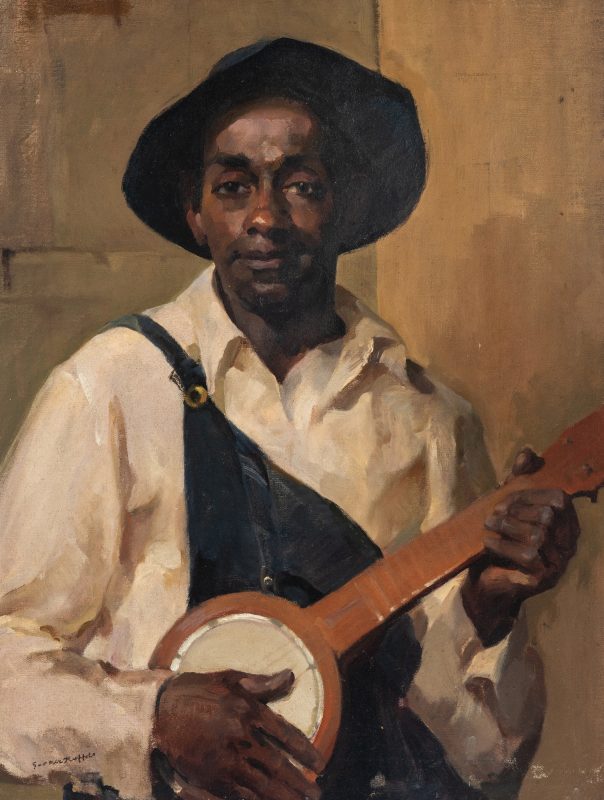 |
|
Oil on canvas painting depicting an African American man playing a banjo and wearing a white shirt, overalls, and hat against a brick background by Gaspare J. Ruffolo (American/Illinois, 1908-1997). Signed “Gaspere Ruffolo” lower left. Housed in a black painted frame. Sight – 25 1/2″ H x 19 1/2″ W. Framed – 28 1/4″ H x 22″ W. American, early/mid 20th century. Biography: Chicago-born Gasper Ruffolo studied painting at the Art Institute of Chicago with Wellington Reynolds and George Oberteuffer, and exhibited at the Art Institute. He was known for his landscapes and portraits, and was a member of the Association of Chicago Painters and Sculptors, Chicago Galleries Association, and the All-Illinois Society of Fine Artists. (source: Peter Hastings Falk, Who Was Who in American Art). |
 |
|
Award winning Cherokee double river cane lidded storage basket, made by Eva Wolfe (North Carolina,1922-2004). Comprised of dyed butternut and bloodroot weavers and woven in the Broken Arrow design. Retains the original Qualla Arts & Crafts Mutual tag and was the 1st place winner of The Cherokee Indian Fall Festival in 1978, ribbon included. 16 1/2″ H x 10 1/2″ W x 10 1/2″ D. 20th century. Signed brochure from the exhibition of Eva Wolfe’s basketry, dated October 28, 1978 accompanies this lot. Nancy Walton collection, Gatlinburg, TN. |
 |
|
Greg Ridley (Tennessee, 1925-2004) hand hammered panoramic gilt copper relief panel depicting The Battle of Shiloh. More information in coming weeks. |
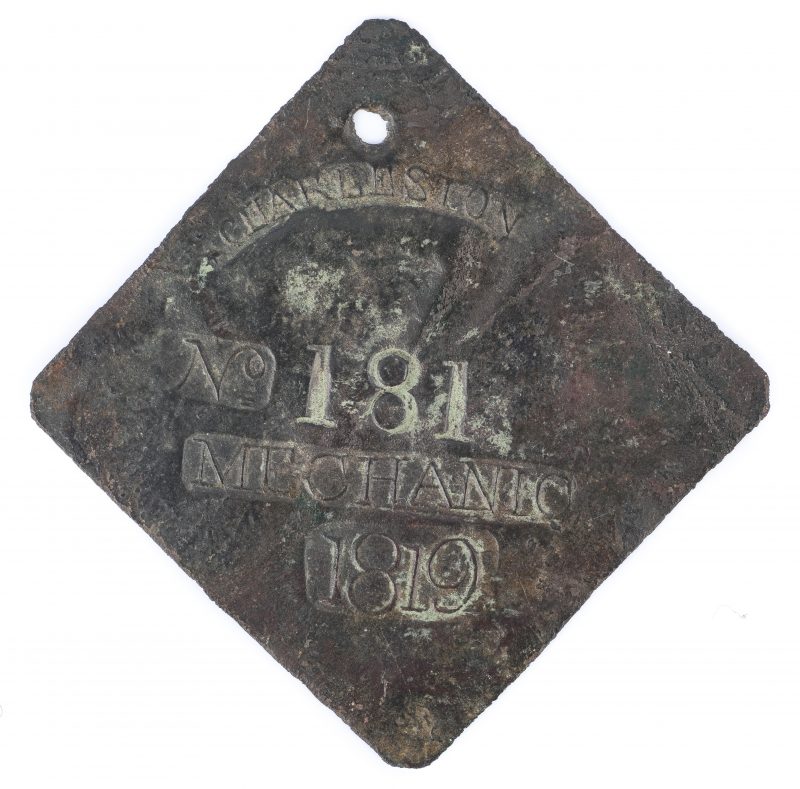 |
|
1819 Charleston Lafar Mechanic Slave Hire Badge, Number 181. Diamond shaped with clipped corners and a hole at the top for suspension. Front marked “CHARLESTON” in a lunate punch at the top, “No.” in a square punch with “181” in individual number punches, “MECHANIC” in a rectangular punch, and “1819” in a rectangular punch at the bottom. Hallmarked “LAFAR” in a rectangular punch on the back. 3.1″ x 3.0″ (79 mm x 76 mm). Provenance: The estate of Jim Maconkey, Landrum, SC. |
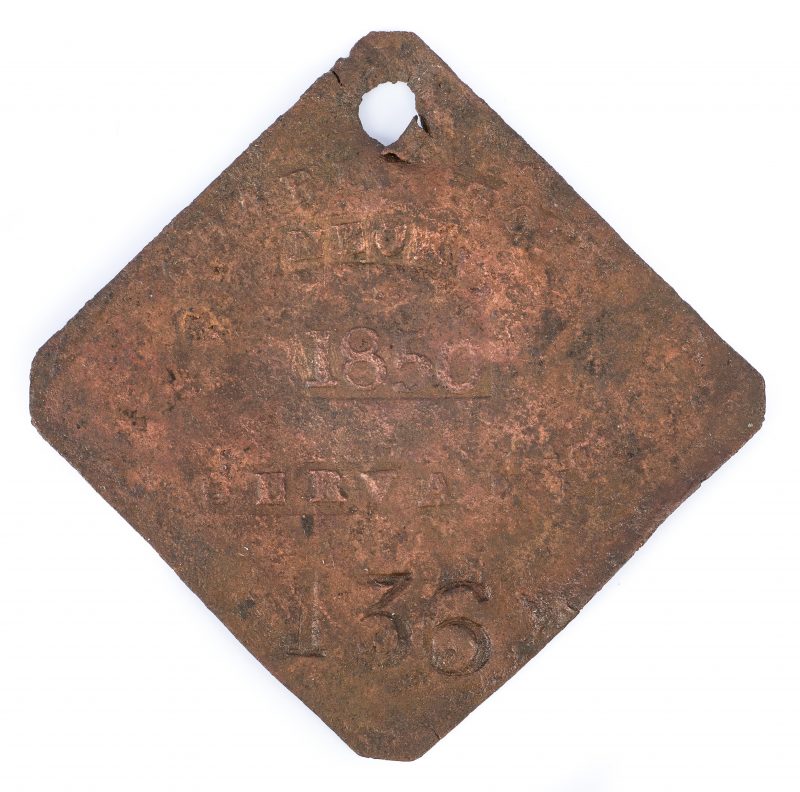 |
|
1850 Charleston Servant Slave Hire Neck Badge, Number 136. Diamond shaped with clipped corners and a hole at the top for suspension. Front marked “CHARLESTON” in a lunate punch at the top, “NECK” in a lunate punch, “1850” in a rectangular punch, “SERVANT” in a rectangular punch, and “136” in individual number punches at the bottom. No hallmarks. This tag was dug by William L. Hunt on December 19, 2007 on St. James Island, SC. Includes a signed document from W. L. Hunt stating the authenticity of the tag, January 1, 2008 along with email correspondence between Hunt and the consignor with additional photographs. 2.1″ x 2.2″ (54.9 mm x 56.1 mm). Provenance: The estate of Jim Maconkey, Landrum, SC. |
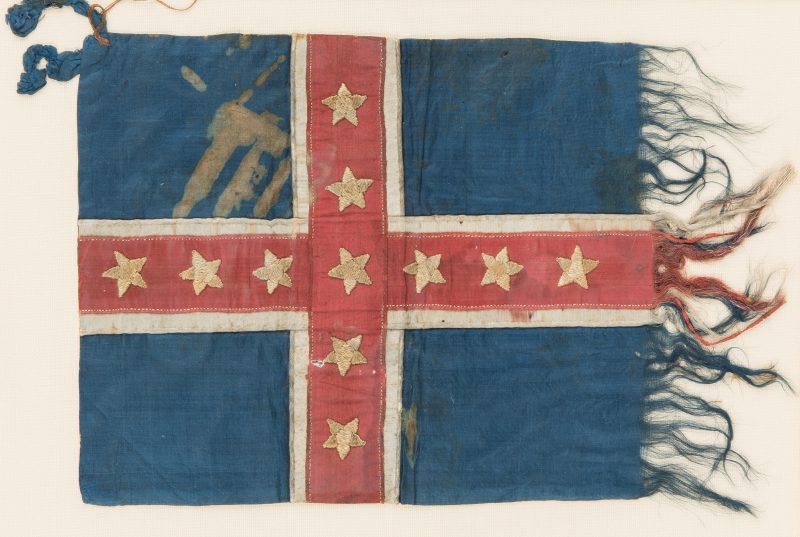 |
|
Confederate Bible Flag with an embroidered cross and letters “Shiloh” verso. More information in the coming weeks. |
 |
|
Confederate Morse Third Type Breech Loading Carbine, .52 caliber, serial number R1007. Breech marked “Morse”. Butternut stocks, brass frame, trigger guard, and butt plate, round rifled barrel, dovetail mounted brass front sight blade and dovetail mounted fixed rear sight, iron breech block. Barrel length – 20″. Overall length – 40″. Provenance: The estate of Jim Maconkey, Landrum, SC. |
 |
|
Civil War Confederate 1862 Pattern Enfield Tower rifle, .577 caliber. Lock plate marked “Tower 1862” with crown, breech marked with “25” proof marks, stock marked with Confederate inspection stamp “JS/(anchor)”, butt plate with blockade mark “6273/A”. Walnut stock, brass butt plate, trigger guard, and fore end tip, iron barrel bands, inlaid iron escutcheons, proper ramrod #1347. Also included is an original document dated March 17, 1862 signed by Gen. John C. Breckenridge to Capt. Brewster a request for 600 Enfield rifles, possible including this rifle. Barrel length – 39″. Overall length – 55″. The estate of Jim Maconkey, Landrum, SC. |
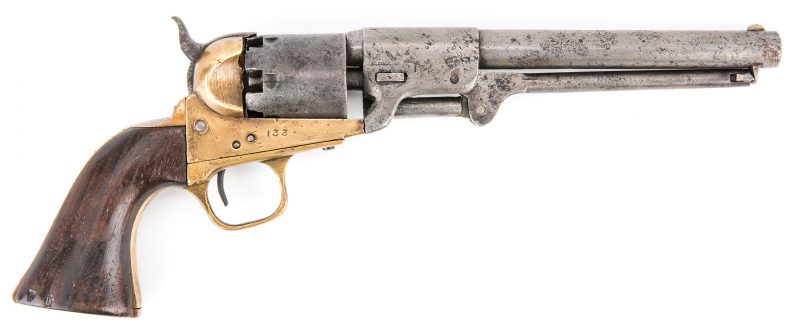 |
|
Confederate Griswold Model 1851 Navy type percussion revolver, .38 caliber, serial number 133, all visible serial numbers matching. Wedge, left side of leading lever, left side of trigger guard and back strap, and interior of grips in channel marked with “V”. Walnut stocks, round barrel, brass trigger guard and back strap, iron mounted, steel frame pins, checkered hammer, standard sights, loading lever. Three ring binder with previous James D. Juilia, Inc. sale record included with the lot. Barrel length – 7 1/2″. Barrel length – 12 1/2″. Provenance: Ex-Dick Kennedy Collection, Atlanta, Georgia. Purchased from James D. Juilia, Inc., April 2017 Ex-Jim Williams Collection, Atlanta, Georgia. The estate of Jim Maconkey, Landrum, SC. Note: This is serial number 133, a most unusual revolver in that it is one of very few noted being a transitional model. The revolver is the earliest standard 1st model with large trigger bow documented. The frame pins are steel which is not normal and as with other early 1st models there are no Roman numerals. |
 |
|
Confederate Thomas Griswold and Company New Orleans, Louisiana Bayonet. Brass and checkered wooden grips, brass attachment ring at the cross guard, blade with flat back and curved single edge. Ricasso marked “THOMAS GRISWOLD & CO. NEW ORLEANS” in an arch. Blade length – 22 3/4″. Overall length – 28 1/2″. Provenance: The estate of of Jim Maconkey, Landrum, SC. Note: This marked Griswold bayonet is one of only two known documented examples. |
 |
|
Civil War era Ames U.S. Model 1849 Rifleman’s Knife with Original Leather Scabbard. Slab-sided walnut grips secured to the tang by three steel rivets, cast brass cross guard, spear point blade. Ricasso marked “US WD.” property mark, obverse, “AMES MFG. CO./CABOTVILLE/1849″ reverse. Original black leather scabbard with brass throat and tip. Blade length – 11 7/8″. Overall length – 18”. Provenance: Nashville, Tennessee private collection. |
 |
|
Large Confederate XX blade knife comprised of a one-piece wood grip, iron D Guard terminating in a tear drop pommel, 1″ width brass ferrule, flat blade with half of blade having top edge beveled terminating in a spear point. Unmarked. Blade length – 19″. Overall length – 23 3/4″. Provenance: Descended from Hoover Family of South Bend, Indiana. |
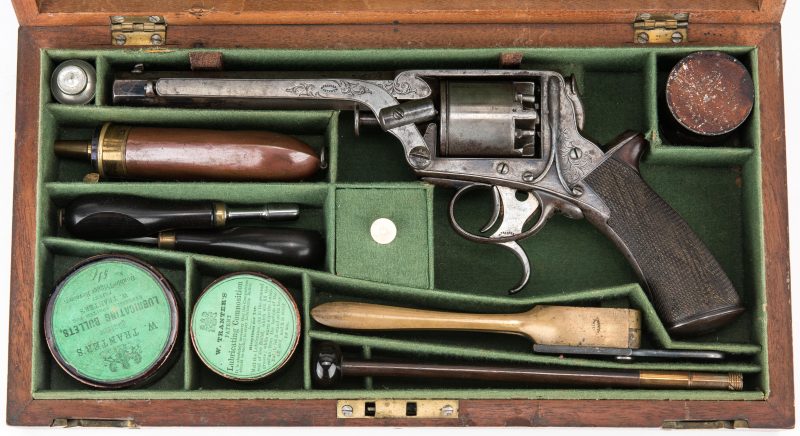 |
|
Cased Pre Civil War Agent Marked Hyde and Goodrich Tranter 3rd Model Double Trigger Revolver, .45 caliber, serial number 8803.T. Top of barrel and breech marked “W. Tranters Patent Hyde & Goodrich Agents for the United States South”, left side of side-mounted loading lever and double trigger marked “W. Tranter Patent”, right side of frame marked with serial number, cylinder marked with proper British proof marks. Checkered English walnut stocks, octagon barrel, iron mounted with foliate engravings, side-mounted loading lever, standard front sight. Housed in a standard English Oak case with brass escutcheons, relined with green felt, containing Tranter’s Patent items including a double cavity flask, cleaning rod, nipple wrench and screw driver (possibly not original to set), and tins of lubricating caps, composition, and candle wax, and James Dixon and Sons Sheffield bag flask and oilier. Barrel length – 6″. Overall length – 12″. Case – 2 1/2″ H x 14 3/4″ W x 7 7/8″ D. Provenance: The estate of Jim Maconkey, Landrum, SC. |
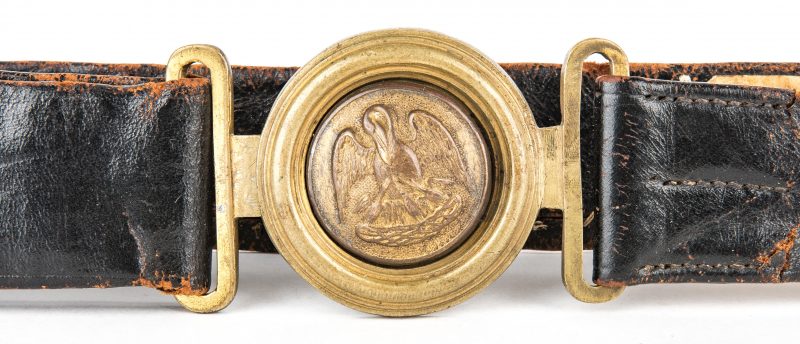 |
|
Confederate Louisiana Officer’s Sword belt with plate on original leather. 2-piece gilt cast brass waist belt plate with applied die-struck tongue medallion depicting the state seal of Louisiana, a pelican feeding her young, surrounded by concentric rings to wreath. Plate approximately 52 mm (53 mm tongue) x 92 mm. Wreath height – 57 mm. Belt length approximately 31″. There is a capture tag affixed to the inside of the belt which is difficult to read but indicates capture at Shilow (Shiloh). Provenance: Cliff Sophia. Originally purchased from Shannon W. Pritchard, Old South Military Antiques. The estate of Jim Maconkey, Landrum, SC. |
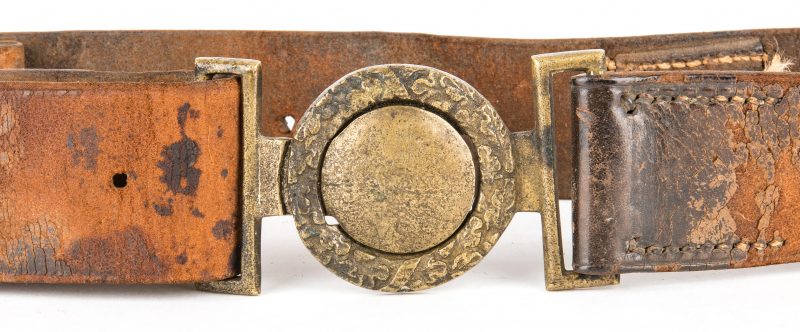 |
|
Confederate Leech & Rigdon waist belt plate on original leather sword belt. 2-piece sand cast brass plain tongue plate, oak leaf wreath with embossed Leech & Rigdon “reverse L” patterns, top and bottom center. Includes original receipt and documentation from Shannon W. Pritchard, Old South Military Antiques. Plate approximately 50 mm x 91 mm. Wreath height – 49 mm. Belt length approximately 30″. Provenance: Originally purchased from Shannon W. Pritchard, Old South Military Antiques. The estate of of Jim Maconkey, Landrum, SC. |
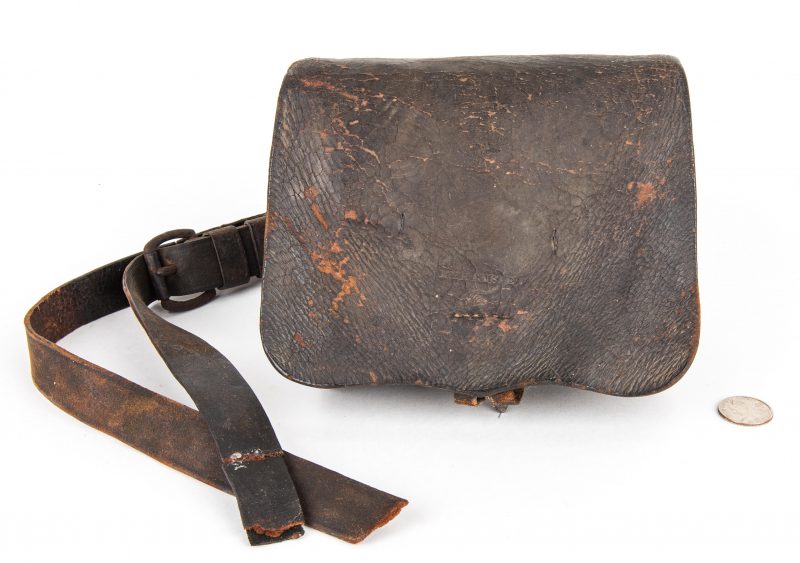 |
|
Confederate McKensie Charleston, South Carolina Leather Cartridge Box. Brown leather, single stitched with scalloped edge to outer flap and lunate interior flap over implement pouch with tab closure. Outer flap marked “MCKENSIE”. Includes closing tab, lead finial, cartridge tin, two belt loops, and shoulder sling mounted by rings. Also includes original Old South Military Antiques catalog listing, catalog listing for similar item, and correspondence between Mike Martin and consignor. Cartridge box – 6″ H x 7 3/8″ W x 2 3/4″ D. Sling length approximately 21″. Provenance: Mike Martin. Originally purchased from Shannon Pritchard, Old South Military Antiques, circa May 2006. The estate of Jim Maconkey, Landrum, SC. |
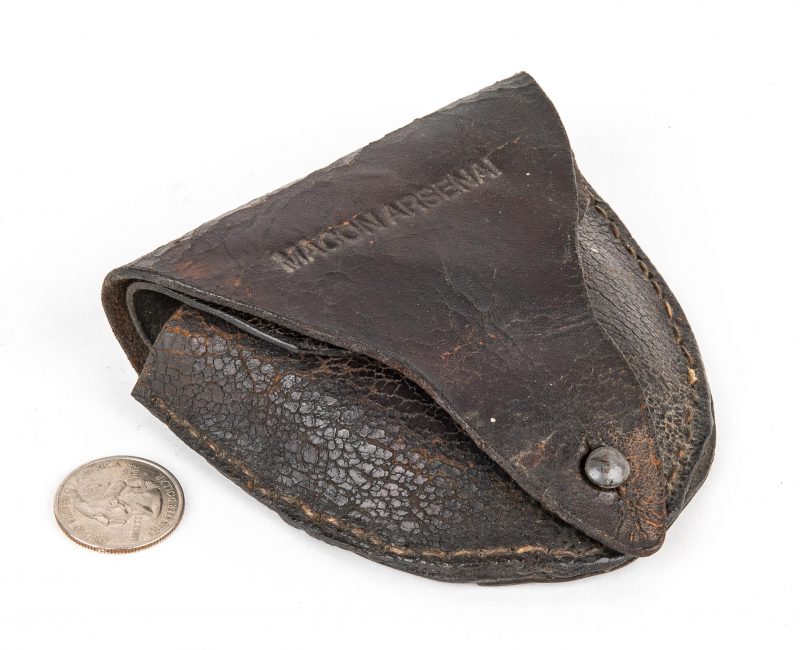 |
|
Confederate Macon, Georgia Arsenal Made “Mule Foot” Leather Cap Box. Dark brown pig leather, single stitched with triangular outer flap and lunate interior flap. Outer flap marked “MACON ARSENAL”. Includes lead finial, closure tab, and single wide belt loop. 4 3/8″ H x 4 3/8″ W x 1 1/4″ D. Provenance: The estate of Jim Maconkey, Landrum, SC. |
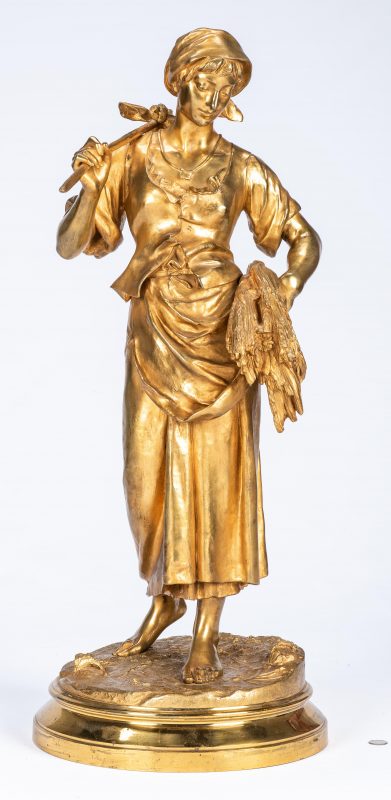 |
|
Eugene Aizelin (French, 1821-1902) gilt bronze sculpture, “La Glaneuse,” depicting a peasant woman, carrying sheafs of wheat in one arm and a knapsack on stick with another, standing atop a craggy base. Signed “E. AIZELIN” on base. 36 1/2″H x 15″ diameter at base, 18″ from tip of stick to elbow. Provenance: private Nashville, Tennessee collection. |
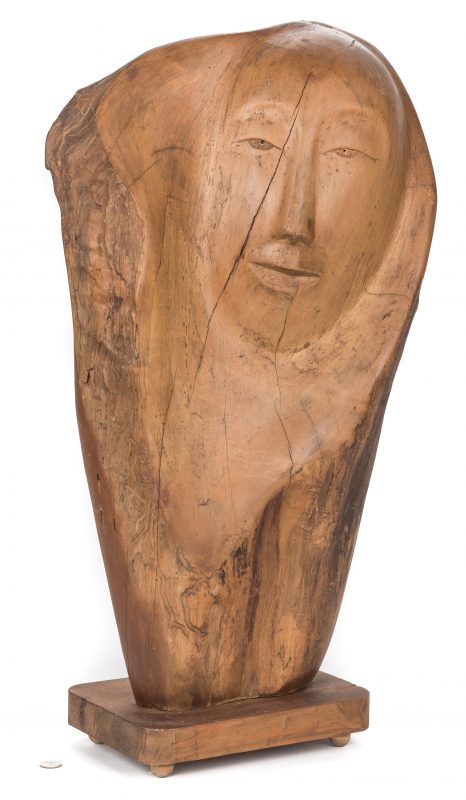 |
|
Large Olen L. Bryant (Tennessee, 1927-2017) carved burl wood sculpture depicting a female face, mounted onto a rectangular wood base. 31 1/2″ H x 17″ W x 8 1/4″ D. Estate of Olen Bryant, Clarksville, TN. |
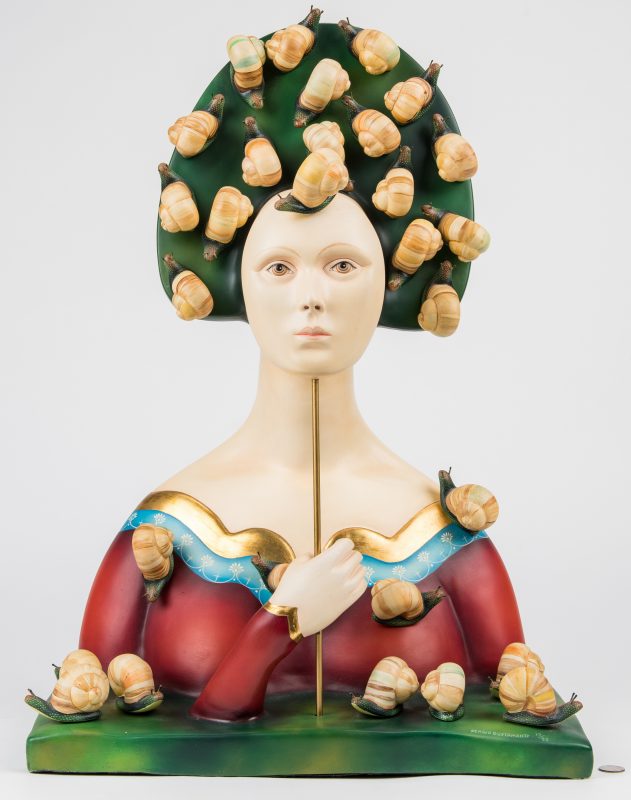 |
|
Sergio Bustamante (Mexico/Holland, b. 1942/43) “Bust with Snails” mid century modern surrealist painted ceramic bust of a female, holding a detachable mask on stick; applied figural snails adorn her body, the base, her shoulders and head-dress. Signed lower right of base and numbered “12/25”. 30″ H x 24 1/2″ W x 14 1/2″ D. Late 20th/early 21st century. |
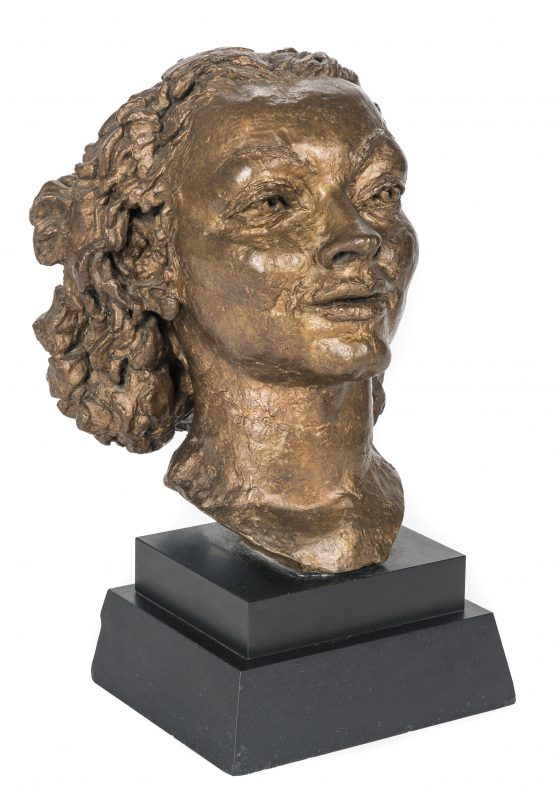 |
|
Sir Jacob Epstein (New York/England, 1880-1959), bronze portrait sculpture of dancer Pola Nerenska, circa 1937. Mounted atop a stepped ebonized base with “Do Not Remove” label for Seattle International Bank. Unsigned. 12″H bronze, 16 1/2″ x 10″ x 12″ overall, including base. Accompanied by a Sotheby’s 1994 sales receipt recording the sale of this work to Thomas Brumbaugh, and a copy of “The Sculpture of Epstein” catalog raisonne by Evelyn Silber, which illustrates and discusses the Pola Nerenska sculpture (no. 283) on page 183. Note: the subject’s name is also spelled Pola Nirenska in some references. According to the catalog, this is one of five known castings by Epstein of the Viennese dancer; one is in the collection of the San Diego Museum of Art, and the plaster is in the National Gallery of Victoria, Melbourne, Australia. Additional ref. Black, p. 242 no. 228; Buckle, p. 238 pl. 365. The estates of Olen Bryant and his partner, the late Vanderbilt art professor Thomas Brumbaugh, Clarksville, TN. |
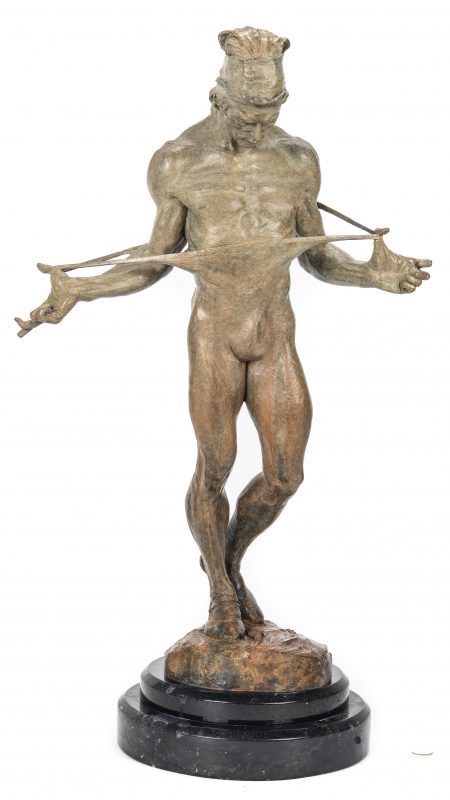 |
|
Richard MacDonald (American/California, born 1946) patinated bronze sculpture titled “Nureyev Half-Life” depicting the male ballet dancer Rudolf Nureyev after a rehearsal. Signed “R. MacDonald” and numbered 68/90. Sculpture mounted on a stepped round base. Sculpture measures 26 1/2″ H x 17 1/2″ W. 29 3/4″ total height. Private Kentucky collection. |
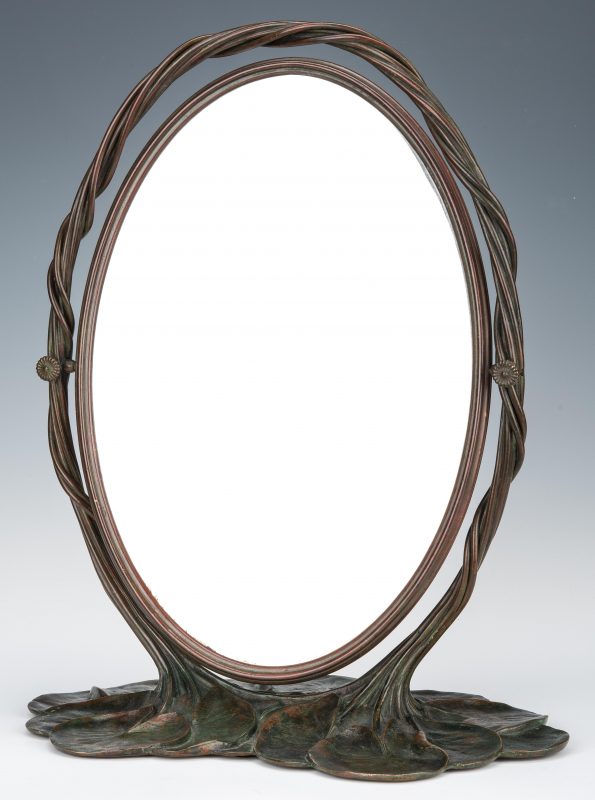 |
|
Tiffany Studios “Lily Pad” Mirror, also known as the Large Pond Lily Mirror; beveled oval dressing mirror framed by sinuous intertwined bronze vines, supported on a lily pad base. Mirror tilts to reveal an engraved script monogram, “LC”, on reverse. Stamped TIFFANY STUDIOS NEW YORK 899 on the back plate and “V” on underside. 19 13/8″ H x 15 1/2″ W x 11″ D. Circa 1904. Provenance: Private Louisiana collection, ex-Macklowe Gallery, New York. |
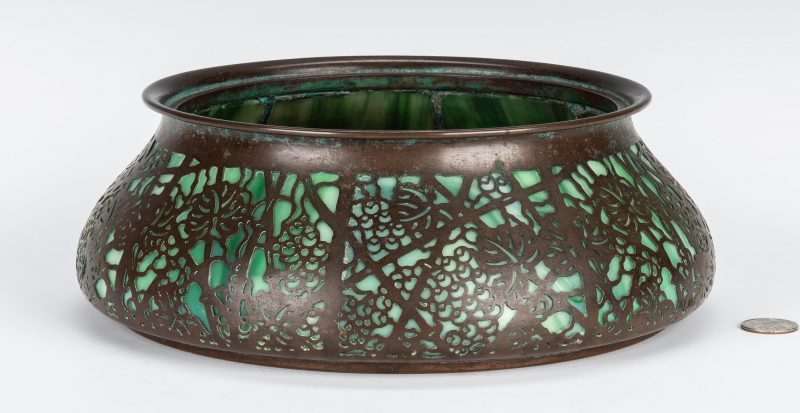 |
|
Tiffany Studios bronze and green slag glass planter, also called a ferner or jardiniere, in the Grape Leaf design, marked on base “Tiffany Studios New York 833”. 3-3/4″ H x 10-3/4″ dia. American, early 20th century. |
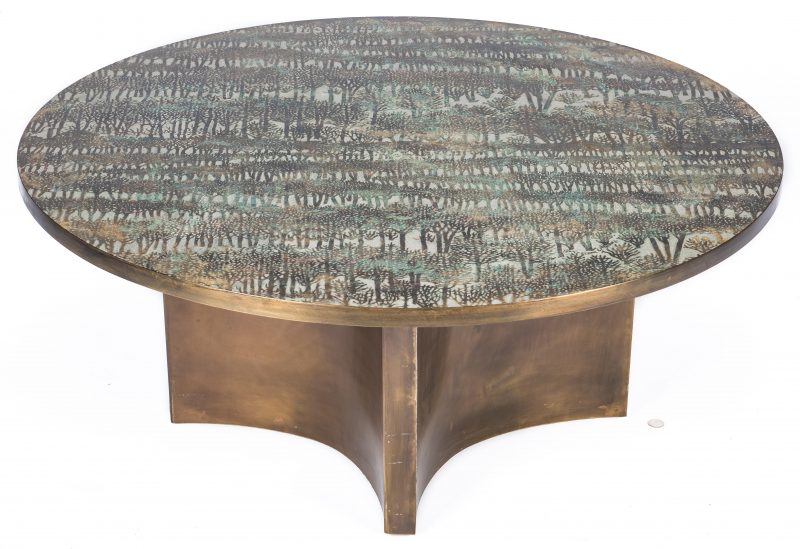 |
|
Philip & Kelvin Laverne “Eternal Forest” design coffee table, low round form; the top having an acid-etched, enameled and patinated bronze and pewter forest design over wood, supported on a shaped bronze pedestal base. Raised “Philip and Kelvin Laverne” signature to top near lower right edge. Accompanied by original Laverne sales brochure. 17 1/4″ H x 42″ dia. American, circa 1970. |
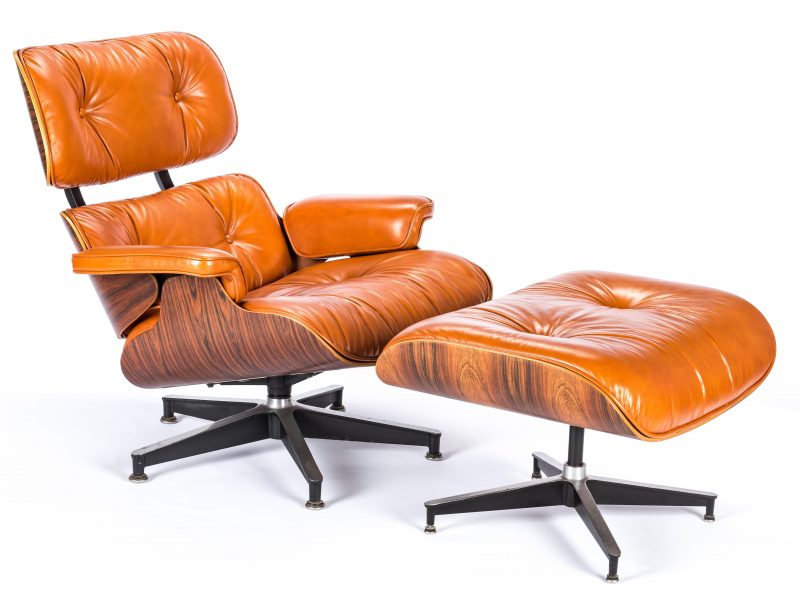 |
|
Eames No. 670 & 671 lounge chair and ottoman, made by Herman Miller and designed by Charles Eames (American, 1907–1978), and Ray Eames (American, 1912–1988). Comprised of Brazilian Rosewood veneer shells with deep orange leather, down filled cushions and cast aluminum bases. Rectangular black Herman Miller label on chair and ottoman base. Designed 1956, made 1956–62. Chair – 32 1/8″ H x 32 3/4″ W x 28″ D. Ottoman – 16 1/2″ H x 26″ W x 21″ D. |
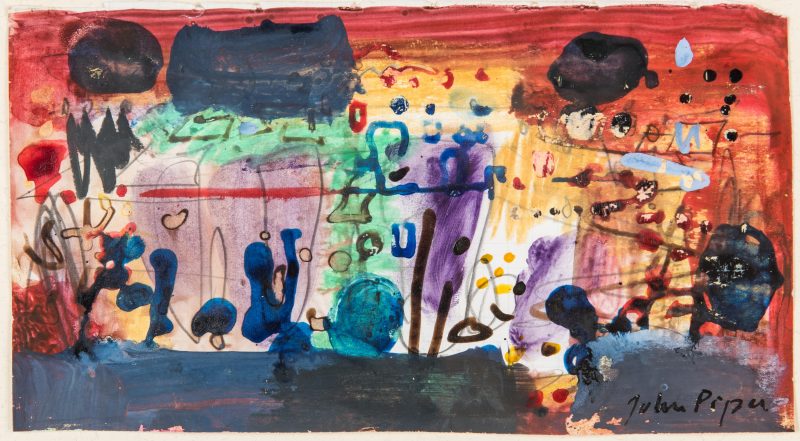 |
|
John Egerton Christmas Piper (Illinois-UK, 1903-1992) mixed media abstract painting, watercolor and gouache on grid paper, signed lower right “John Piper”. Adhered en verso is a note from the artist with printed address Fawley Bottom Farmhouse near Henley-On-Thames, reading “Dear Mr. Brumbaugh, I am a great putter-aside of letters, & I’m afraid I put aside yours of last July. However, I’ve got around to it at last! All Good wishes, Yours sincerely, John Piper.” Note: Tom Brumbaugh was the late partner of Olen Bryant. Clarksville TN framing label en verso. Painting is float mounted on an ivory mat in a black narrow molded frame. Painting 4″ x 7 1/4″, frame 9″ x 12″. Estate of Olen Bryant, Clarksville, TN. |
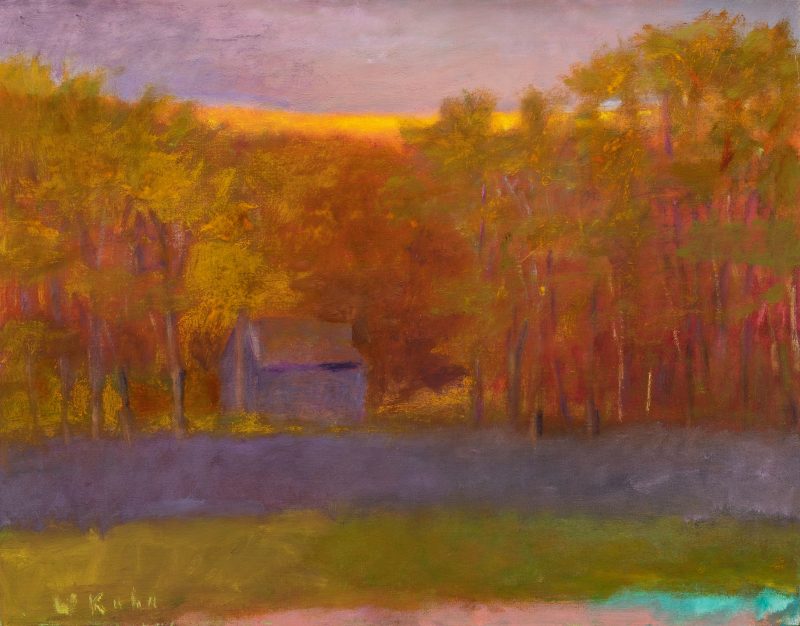 |
|
Wolf Kahn (b. 1927/New York, Vermont / Germany) oil on canvas or linen painting, “Glow on the Ridge,” colorful landscape depicting a cabin set amid fiery yellow and orange trees, with a purple and yellow sunset overhead. Signed lower left. Numbered 97-1990 and titled in pen en verso. Label en verso from the Jerald Melberg Gallery, Charlotte, NC. Float mounted in a giltwood molded frame. 22″ x 28″ sight, 32 3/8″ x 26 3/4″ framed. Provenance: Private Middle Tennessee collection, purchased from Jerald Melberg Gallery circa 1990. |
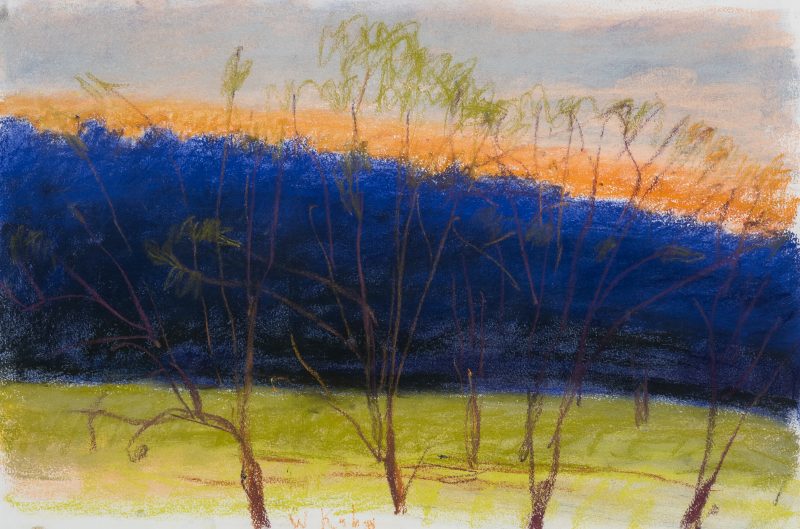 |
|
Wolf Kahn (b. 1927/New York, Vermont / Germany) pastel on Somerset paper landscape titled “Evening Breeze,” vividly depicting nearly bare treetops set against a violet and orange sky. Signed lower center. Jerald Melberg Gallery label en verso with number #4029. Hinge mounted to wide white mat and housed in molded giltwood frame. Somerset watermark upper right. Circa 1998. Sheet: 15″ H x 22″ W. Sight – 14″ x 21 1/4″. Framed – 25″ x 31 1/4″. Biography: Wolf Kahn studied under Abstract Expressionist painter Hans Hofmann (later becoming Hofmann’s studio assistant) and at the University of Chicago. He is known for his works which which blend abstractionism and realism with Color Field painting. Provenance: Private Middle Tennessee collection. |
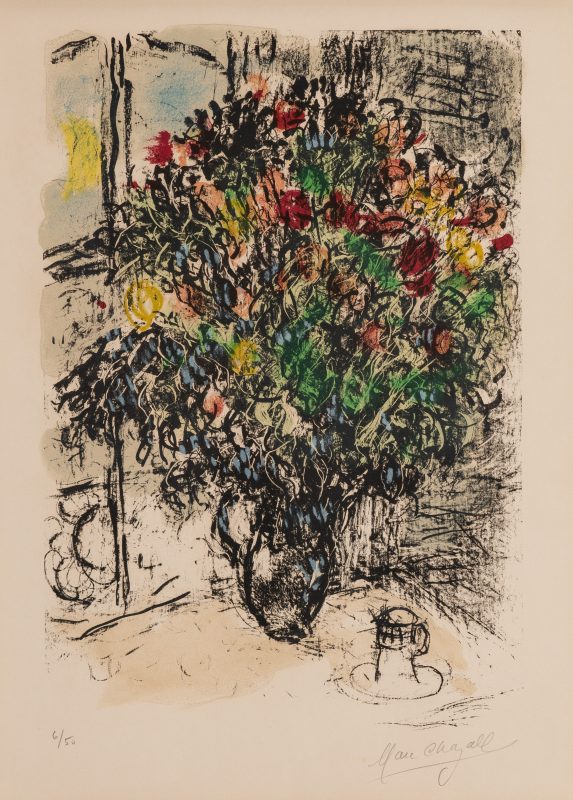 |
|
Marc Chagall (Russian/French, 1887-1986) limited edition color lithograph titled “The Red Bouquet (Le Bouquet Rouge)” depicting a large bouquet of flowers resting on a table by a window, with the sun visible in the background. Pencil signed lower right and numbered in pencil 6/50 lower left and printed on Arches watermarked wove paper, watermark visible center right side matte margin. Created October, 1969. Mounted with corner points to mat and housed in a contemporary gilt wood frame. En verso “Red Bouquet M 580.” Sheet: 29 13/16″ H x 21″ W. Image: 22″ H x 15″ W. Matte: 25″ H x 16 5/8″ W. Framed: 38 1/2″ H x 31 1/2″ W. |
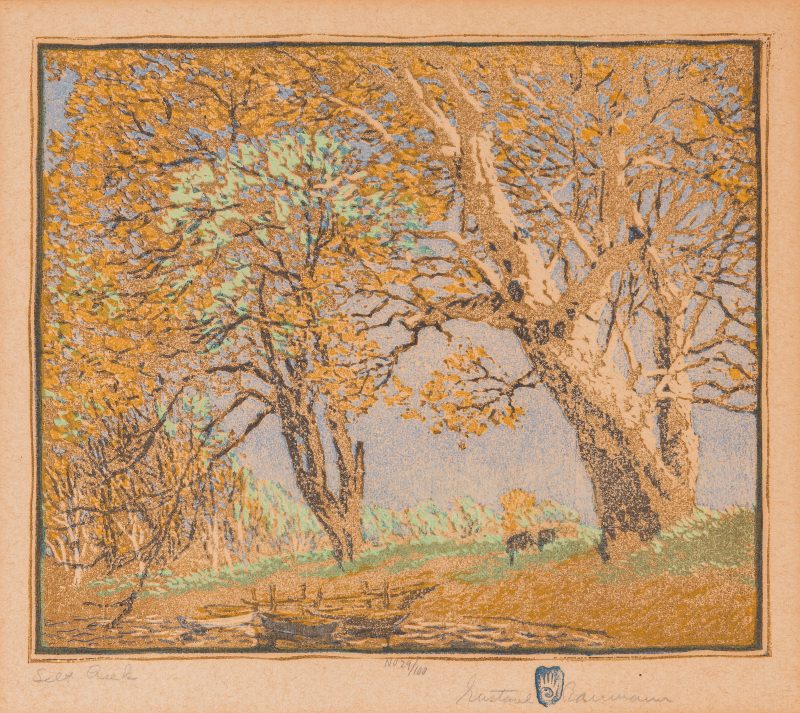 |
|
Gustave Baumann (1881 – 1971, New Mexico/California) color woodcut on tan laid paper titled “Salt Creek”. Titled in pencil lower left, numbered 29/100 center margin and signed lower right. Sight – 10 7/8″ H x 12 1/4″ W. Framed – 21 1/2″ H x 21 5/8″ W. |
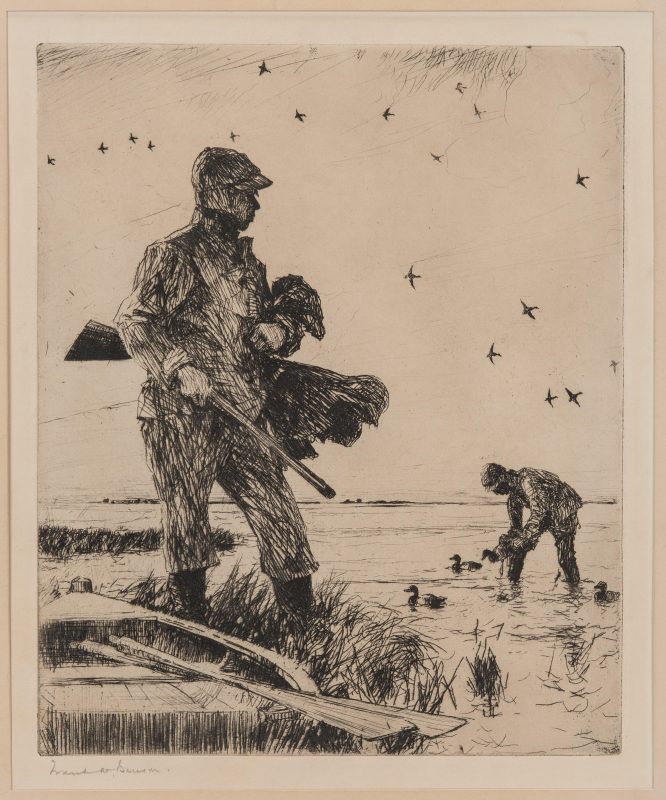 |
|
Frank Weston Benson (American, 1862-1951) etching titled, “Winter Wildfowling”. Signed lower left margin, “Frank W. Benson”. Circa 1927. Sheet 15″ H x 12 5/8″ W. Image 12″ H x 9 3/4″ W. Hinged on side. |
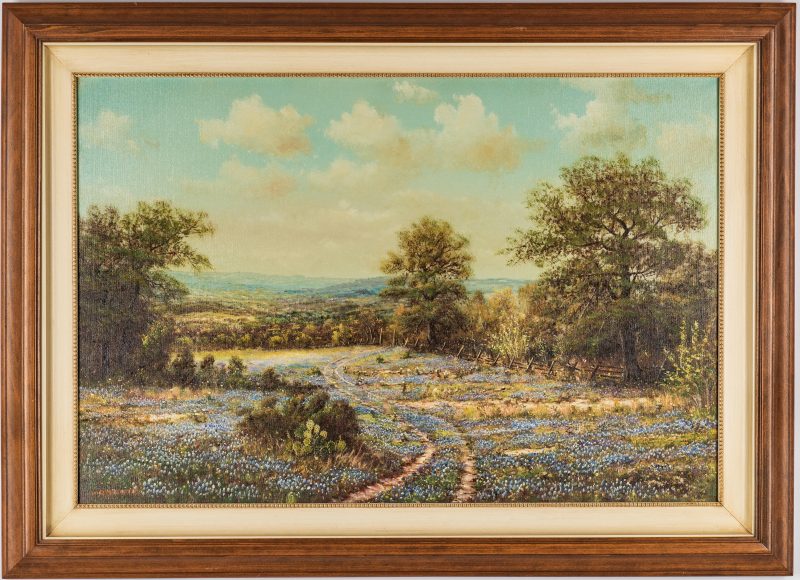 |
|
Large William R. Thrasher (Texas, 1908-1989) landscape painting depicting a road leading through a field of bluebonnets and a wooden fence, with trees and hill country in the background. Signed lower left. Stained and painted wood frame. Previous owner name and address written in ink en verso of frame. 35 1/2″ x 23 1/2″ sight, 32″ x 44″ framed. Provenance: estate of D.L. Collins, Abilene, Texas. |
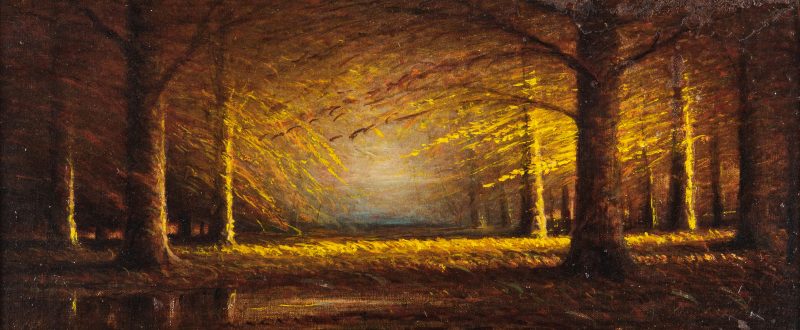 |
|
Harvey Joiner (Kentucky/Indiana,1852-1932) oil on board landscape painting depicting a forest with autumn leaves, a ray of sunlight shining through the beech trees. Signed “Harvey Joiner” lower right (inconspicuous due to color and location). Gilt metal placard with artist’s name, affixed lower center of frame. Housed in a giltwood frame. Sight – 5 3/4″ H x 13 1/2″ W. Framed – 12 1/4″ H x 20″ W. Biography: A painter, Harvey Joiner did portraits including the first five governors of Indiana and also worked in St. Louis where it is thought he studied with David Hoffman. At age 16, he began sketching scenes of African-Americans on the Mississippi River Boats, and by 1880, he had established a studio in Louisville, Kentucky and specialized in scenes of Kentucky beech woods. He also painted allegorical subjects. (source: Who Was Who In American Art). |
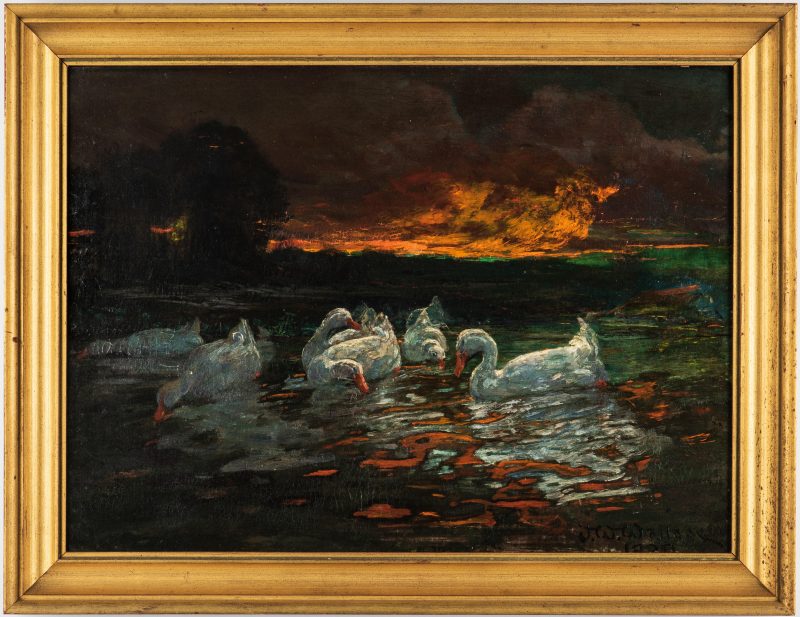 |
|
James Wiley Wallace (Tennessee, 1852-1921) oil on canvas landscape depicting a group of swans on a lake at sunset, with orange sky reflected in the water below. Signed “J.W. Wallace” and dated “1909” lower right. Housed in a molded giltwood frame. 22″ x 16″ sight, 20″ x 26″ framed. American, early 20th century. Biography: James Wiley Wallace played a prominent role in Knoxville’s artistic and civic scenes at the turn of the 20th century. He had no fewer than 16 original works exhibited at the 1910 Appalachian Exposition of Fine Art in Knoxville in addition to 7 monotypes. In addition to being an artist who depicted rural life and regional history, he served as editor and chief of the Knoxville Daily Tribune from 1880-1887. An interesting 1882 Harrisburg, PA newspaper article references a street encounter between William Rull, editor of the Republican “Chronicle” and Wallace, editor of the Democratic “Tribune”. The altercation stemmed from a derogatory article Rull wrote about Wallace. Rull struck Wallace and Wallace responded by drawing a revolver and firing at Rull, missing him. Ironically, Wallace later served as a justice of the peace in the mid 1890s. |
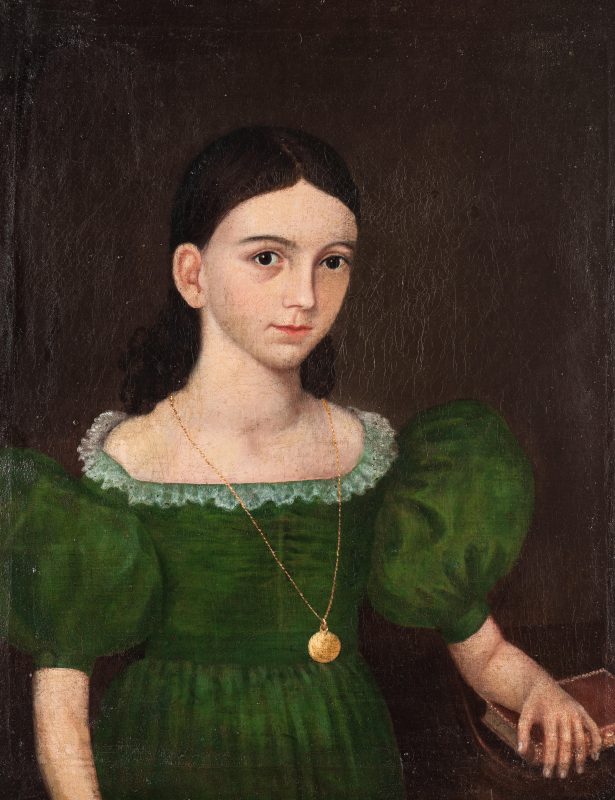 |
|
Oil on canvas folk art portrait of a dark haired girl, believed to be Annie Eliza Tomkins Harrison of Sumner County, Tennessee (b. 1831 -d. 1878). The subject is depicted wearing a green high waisted dress with pouf sleeves and gold locket around her neck, and is posed slightly turned to her left, with her left arm resting on a table and a book. Housed in a simple cove molded gilt wood frame. 24 1/2″ H x 20 1/2″ W Sight. 28 1/2″ H x 24 1/2″ W Framed. Circa 1840. Provenance: descended in the Tomkins family of Sumner County, Tennessee family to present consignor. Eliza Tomkins, also spelled Tompkins in some references, was the daughter of Mary Henderson Madden Tomkins (1811-1846) and John Randolph Augustus Tomkins (1800-1879), a prominent landowner, militia captain, merchant and civic leader. Mr. Tomkins was also a trustee of the Sumner Female Academy. Eliza was the couple’s only daughter and seems to have lived in Sumner County all her life. She married W.A. Harrison, a Presbyterian minister in Gallatin. The portrait descended to the consignor through one of Eliza’s four brothers, Dr. William R. Tomkins (1837-1887). The artist is unknown and may have been an itinerant painter passing through the area. |
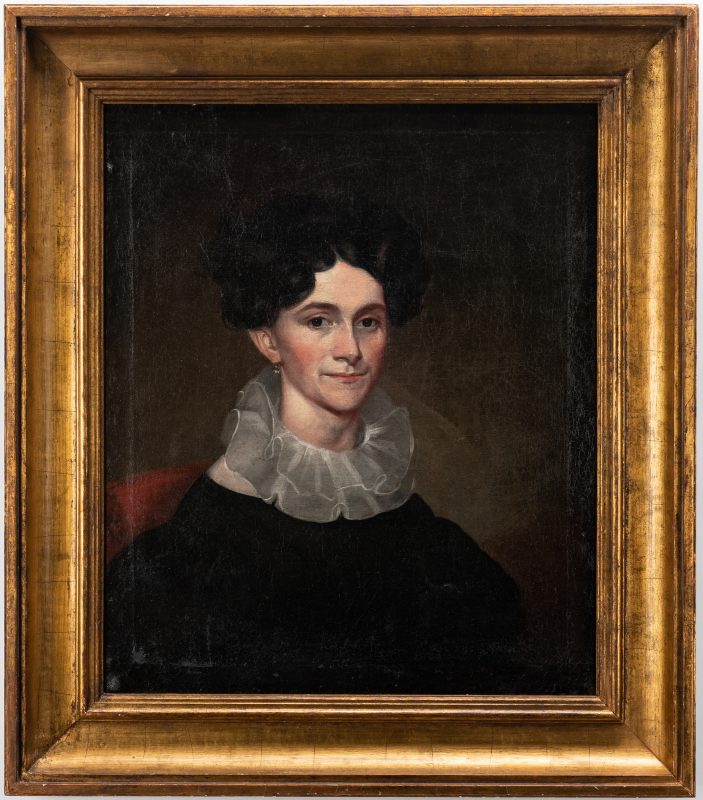 |
|
Attributed to John Grimes (Tennessee, 1804-1837), bust length portrait of a brown eyed, dark haired woman, likely Tennessee. The subject is depicted with upswept curls and wearing a sheer white ruffled collar and black dress, with small gold earrings, and seated in a red chair. Board on back of frame reads “Davidson Co. Tennessee.” 24″ x 20″ sight, 32″ x 28″ in wide cove molded giltwood frame. Biography: Kentucky-born John Grimes trained with Matthew Jouett and came to Nashville in about 1829, the same time Ralph Earl was departing for Washington, DC with his friend Andrew Jackson, who had been elected President. Grimes seems to have stepped in to Earl’s role as the “go-to” painter for wealthy Middle Tennesseans desiring to have their likenesses painted, until his untimely death in 1837. (Source: Edward Pattillo, Alabama Heritage, No. 63, Winter 2002). |
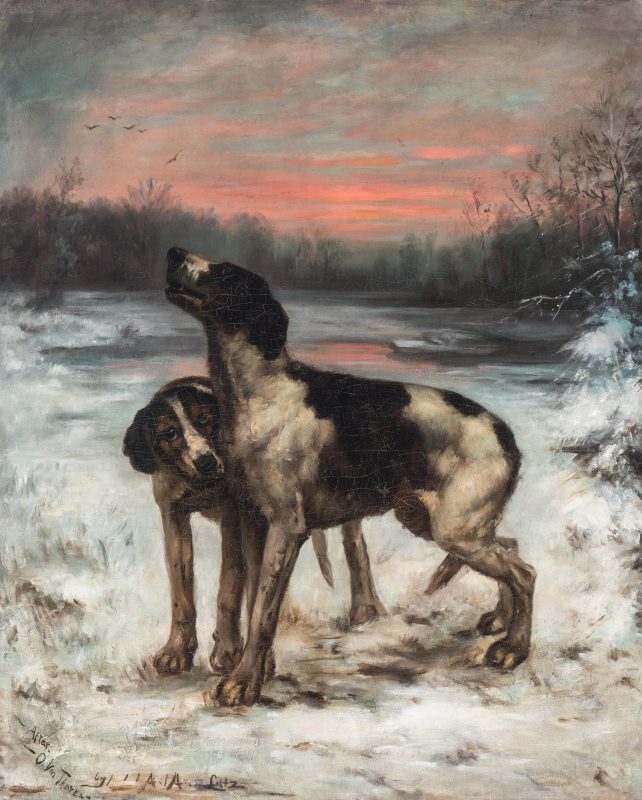 |
|
Adelia Armstrong Lutz (American/Tennessee, 1859-1931) large oil on canvas winter landscape depicting two hounds standing in an open field with a luminescent sky in the background, one hound seemingly hiding behind the other, after the original by Otto Ritter von Thoren (France/Austria, 1828-1889). Signed lower left “After O. Von Thoren by A. A. Lutz” and stamped en verso “Copied from the original at the Corcoran Gallery”. Housed in a contemporary carved wood frame. Sight – 37 1/2″ H x 30 1/2″ W. Framed – 46″ H x 38 1/2″ W. Biography: Adelia Armstrong Lutz (1859-1931) was known for painting portraits, landscapes, and still lifes. She was born in Jefferson County, Tennessee. She studied art at the Corcoran Gallery in Washington, D.C., at the Pennsylvania Academy of Fine Arts, and abroad. Upon her return to Knoxville in 1887, she was a director of the Knoxville Art Club and co-organized the Nicholson Art League. She married John Edwin Lutz in 1885 and they built their home, “Westwood”, on Knoxville’s Kingston Pike in approximately 1890. Provenance: Property of a direct descendant of Adelia Armstrong Lutz. |
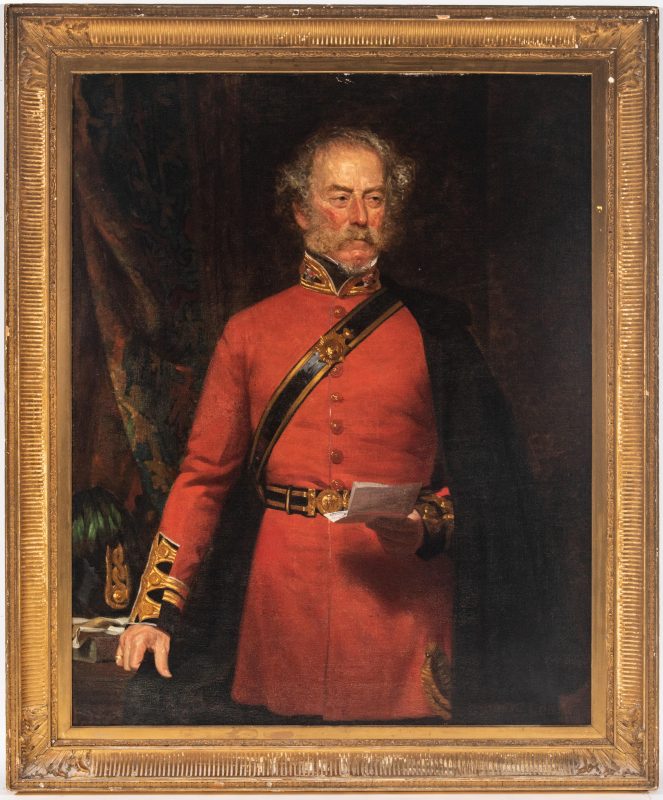 |
|
Norman MacBeth (England/Scotland, 1821-1888) oil on canvas three-quarter length portrait of a British Officer. The subject, with gray hair and mustache, attired in his red uniform coat with sword partially visible beneath his cloak, is depicted standing with his right hand resting atop a book on a table; patterned drapery hangs in the background. Signed “Norman Macbeth” and dated 1864, lower right. Housed in the original giltwood cove molded frame with guilloche and floral scroll bands and carved corner elements. Sight: 49 1/2″ x 30 1/4″. Framed: 60″ x 49 1/2″. |
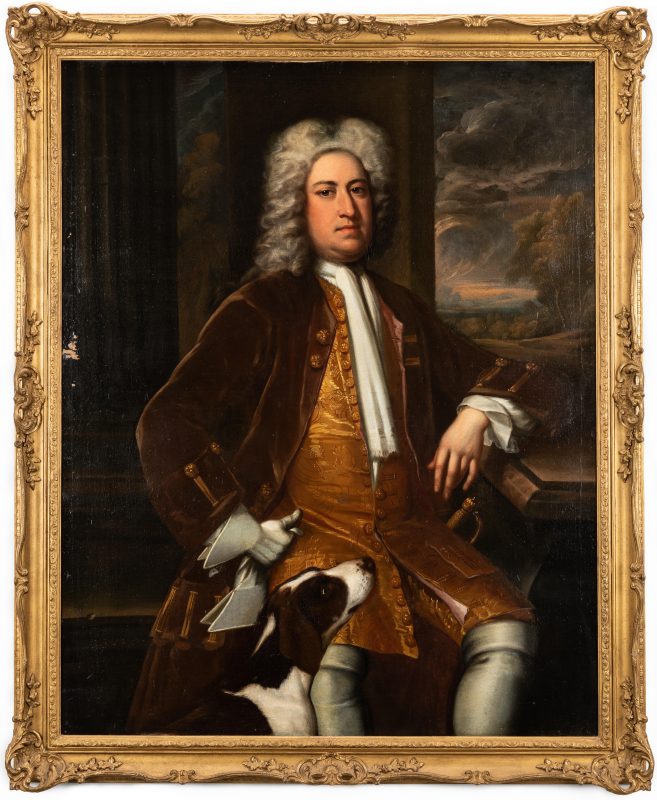 |
|
Circle of Thomas Hudson (English, 1701-1779) or Jonathan Richardson (English, 1667-1745), portrait of a gentleman with dog and sword. Subject is depicted in a fine brown velvet coat with gold buttons and braid, gold colored silk vest, and breeches, wearing a wig and seated with his elbow resting on a table, holding his left hand glove in his gloved right hand. The handle of his sword is visible at one side, and a dog looks up at him from his other side. Column and landscape with rolling clouds in background. Unsigned. Later inscription en verso attributes the painting to Thomas Hudson. Housed in an old but likely not original giltwood Rococo style frame. 48 1/2″ x 38 1/2″ sight, 55 1/2″ x 46 1/2″ frame. Biography (Courtesy the National Portrait Gallery, London): Jonathan Richardson was one of the most successful native-born English portraitists of the first decades of the eighteenth century. He owned a superb collection of Old Master drawings. His book, Theory of Painting, published in 1715, inspired the young Joshua Reynolds to become an artist. Devon-born Thomas Hudson trained under Jonathan Richardson, later marrying his daughter, and built a fashionable portrait painting practice thanks in part to influential friends including William Hogarth, with whom he travelled to France, Holland, and Flanders. He was known as both a portrait painter and art collector. |
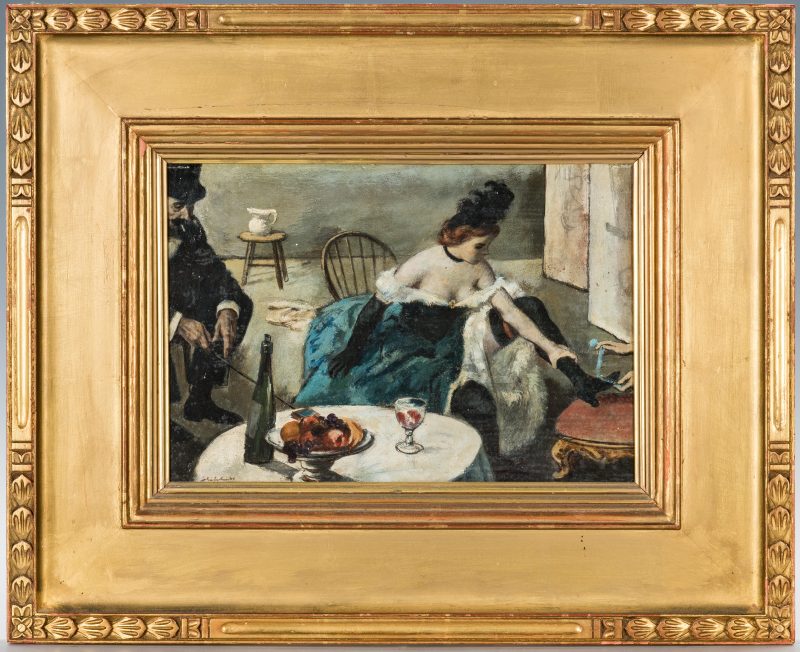 |
|
Benjamin Albert Stahl (1910-1987) oil on board illustration of a cabaret dancer and older man. The painting depicts a voluptuous cabaret or can-can dancer in feathered headdress and low cut gown, seated backstage, her leg raised on a footstool so her shoe can be tied and revealing a red garter; beside her sits a much older bearded man in black stovepipe hat, looking bored and poking at his cigarette case with a cane. A still life composition with compote of fruit, bottle and glass of wine is in the foreground, while a pitcher sits atop a stool in the background. Signed lower left “Stahl” and dated ’44. “13” inscribed en verso. 13″ x 9″ board, 20 1/2″ x 16 3/4″ framed. Later giltwood frame with carved husks and rosettes at corner. Note: this painting, heavy with influences of Degas and Cezanne, was likely an illustration for the Saturday Evening Post or Esquire, both two of Stahl’s most reliable editorial clients during the 1940s. Stahl studied at the Chicago Art Institute and went on to work as one of America’s best known illustration artists. Starting with the Chicago Tribune, he soon went to work for a number of widely circulated periodicals. Frank Kilker, editor of the Saturday Evening Post, was said to have held the most intriguing manuscripts for Stahl to illustrate. The National Academy of Design awarded Stahl its highest honor, the Saltus Gold Medal in 1949 for his painting “Circus People”. He went on to have a successful career as an illustrator of children’s books. He also founded the Famous Artists School in Westport, CT and also taught at the Chicago Academy of Fine Arts. He was inducted into the Society of Illustrators Hall of Fame in 1979. Source: Society of Illustrators museum website; Askart. |
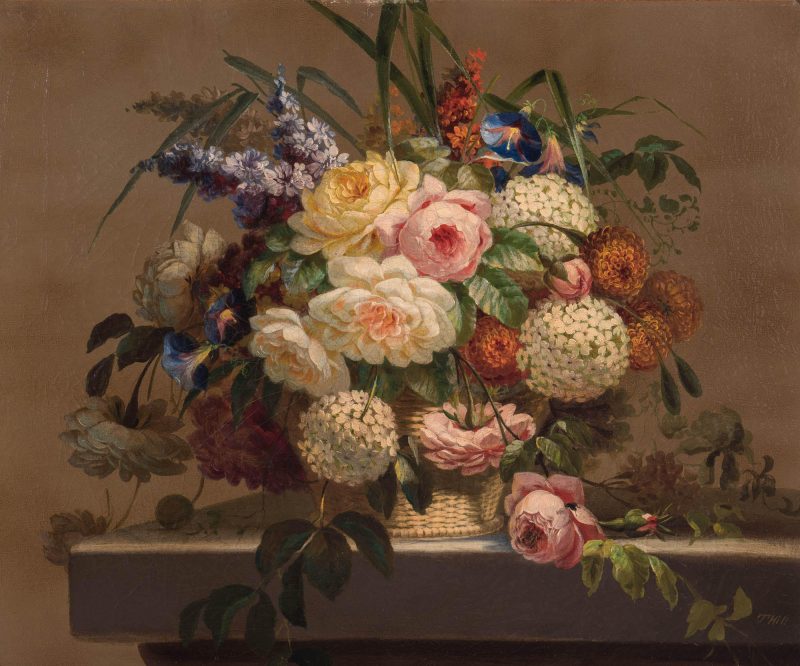 |
|
Thomas Hill (California/Massachusetts, 1829-1908) oil on canvas still life painting depicting a wicker basket of flowers, sitting on a tabletop; a house fly is perched atop a rose which has fallen to the table. Signed lower right “T. Hill”. Housed in an antique, possibly original giltwood frame with carved Rococo style corner decorations and molded rabbet edge. 20″ x 24″ canvas, 28″ x 32″ framed. Mid/late 19th century. |
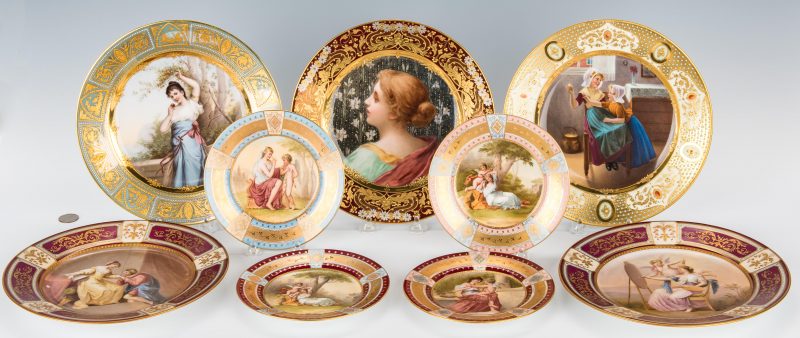 |
|
Sampling of European painted cabinet plates. Artists include Wagner, Bauer, and Berg. Late 19th – Early 20th century. Property of the Hunter Museum of Art, being sold to benefit future acquisitions. |
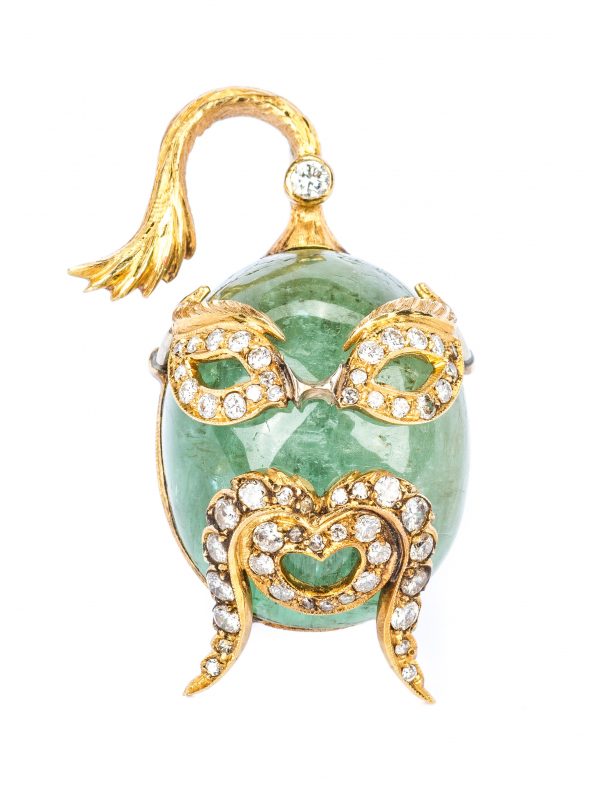 |
|
Guilio Nardi, Venice, Italy, cabochon emerald jeweled pendant or brooch, bust of a Chinese Scholar or theater character with total 55 round diamonds in hair, diamond mask eyes, mustache and mouth. 18K yellow gold handmade mounting, the back with crossed machetes, chevron and cutwork decoration. Mounted with double-prong fur pin clasp, 7 x 6mm (interior) bail for pendant and 5 mm L hook to mount figure upside down. Marked en verso of ponytail: G. Nardi 750. 47mm H x 30mm W. 33 grams. Mid 20th century. |
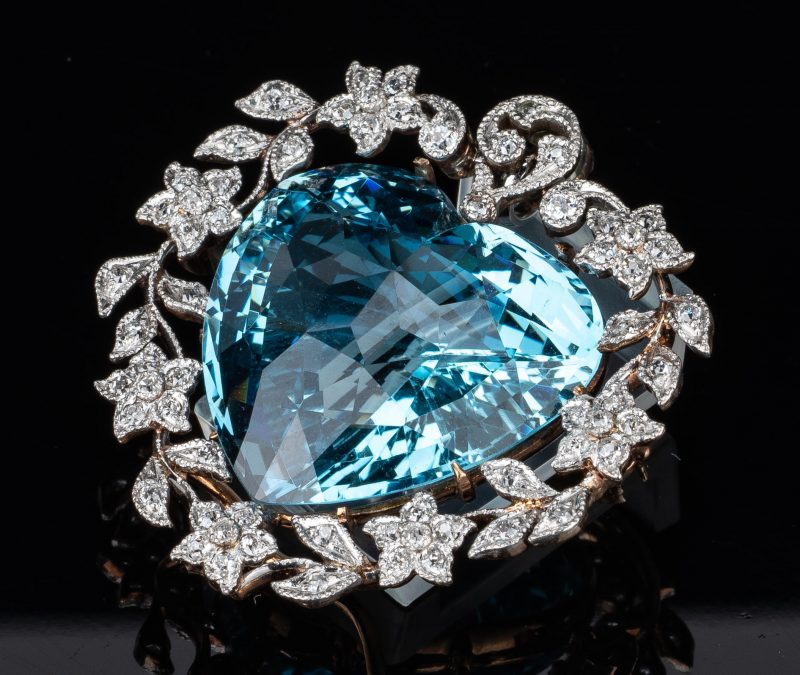 |
|
29.33 ct. heart-shaped blue transparent aquamarine framed in 14K diamond floral and leaf scroll mounting containing 64 single cut round diamonds. Pendant: 1 3/8″ x 1 5/16″, 14.4 grams. See GIA report #2193892897 dated 12/03/2018 stating Aquamarine weighs 29.33 carats, Heart Shaped, measures: 21.08 x 21.82 x 12.43 mm, Rose Cut crown, Modified Step Cut pavillion, Transparent, Blue color and Natural Beryl species. Together with 18K white gold 18 1/2″ long chain, 3.2 grams. |
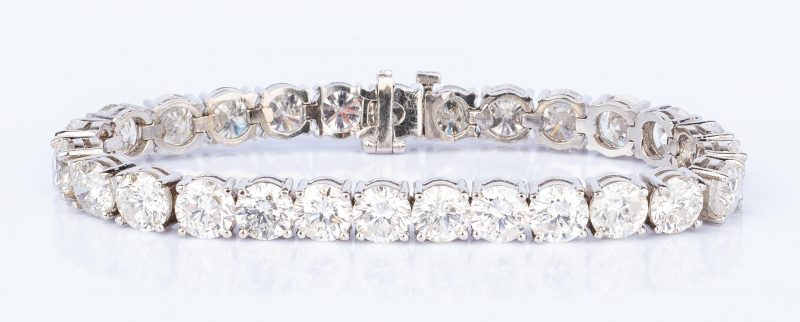 |
|
27-carat diamond line bracelet containing 27 round brilliant cut diamonds, each diamond weighing approximately one carat, color approximately I-J and clarity approximately I1-I3. Total diamond weight approximately 27 carats. Diamonds are mounted in 14K white gold four-prong flexible mounting with invisible clasp with safety bar clasp measuring 6-3/4 inch interior circumference. Marked 14K on clasp. 25.9 grams. Purchased from Adler’s of New Orleans, Louisiana. |
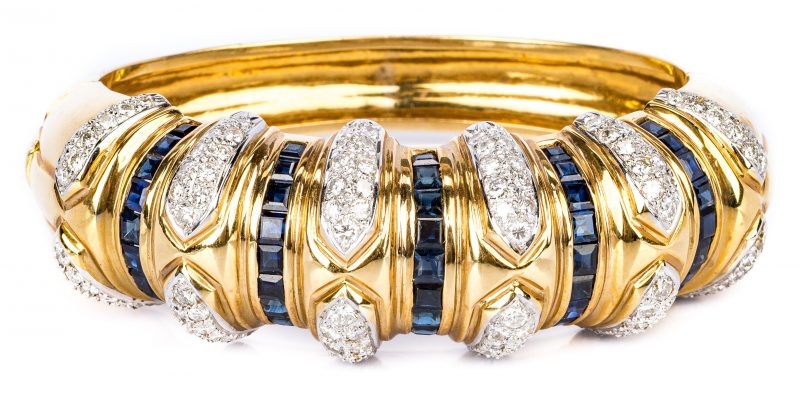 |
|
One 18K yellow gold ribbed top bangle bracelet containing forty-five (45) square cut natural blue sapphires weighing an estimated 6 carats together and 132 round brilliant cut diamonds weighing an estimated 4-1/2 carats combined (VS1-SI1 clarity and F-G color). Maker’s mark, 750 18K on interior of clasp. 6-3/8 inch interior, hinged oval bangle. 7/8″ at widest on top. 51 grams. From a large Nashville estate collection of jewelry. |
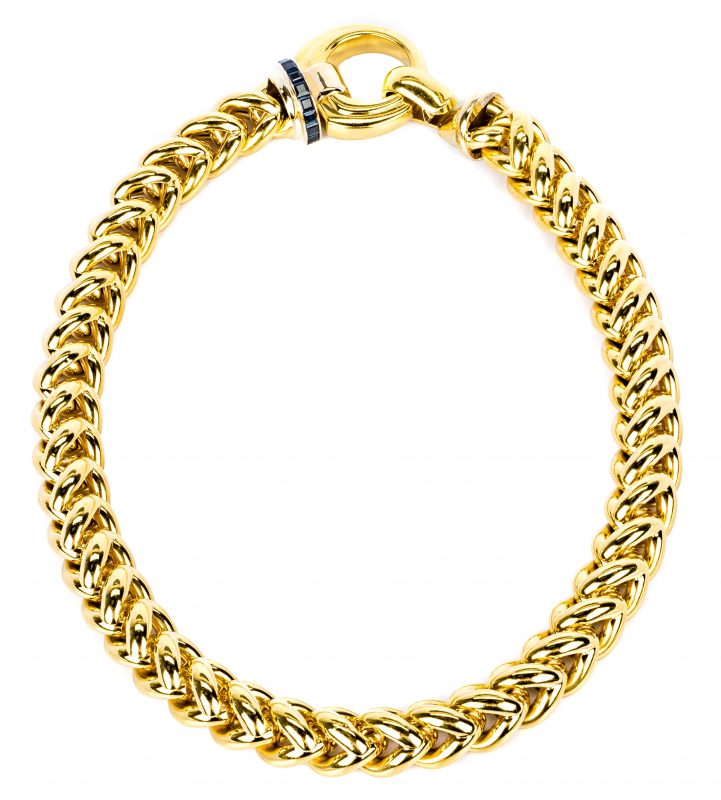 |
|
One 18K yellow gold Signoretti braided stampato link choker necklace with hook and ring clasp inlaid with eleven square cut blue natural sapphires next to the round clasp. Maker’s mark worn. Marked Italy, 18K on clasp. 17 inches long. 120.4 grams. From a large Nashville estate collection of jewelry. |
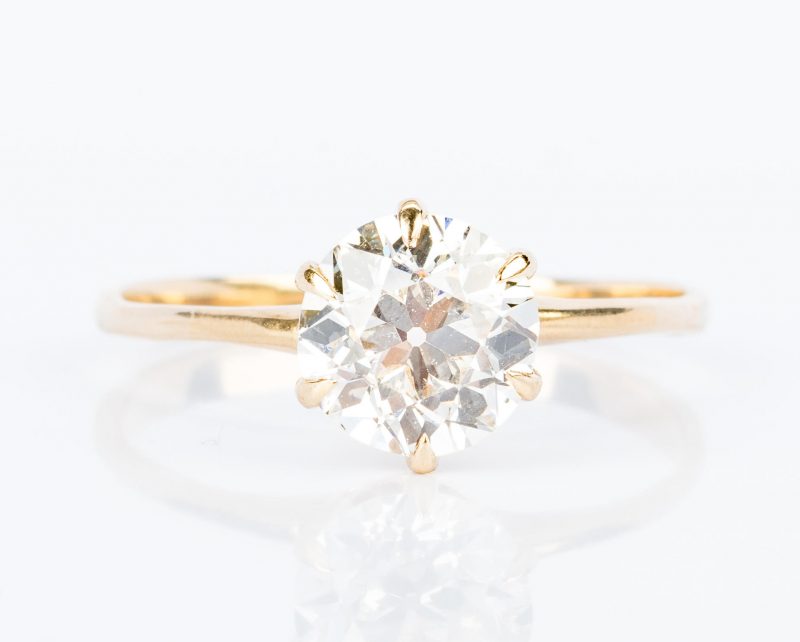 |
|
One (1) lady’s 14K yellow gold engagement ring containing an old European cut diamond in six prongs. The diamond measures 7.79 to 8.01 mm in diameter by 4.87 mm deep and weighs an estimated 2.00 carats; it is approximately SI1 clarity and K color with very good cut grade. Ring size 9. 2.7 grams. |
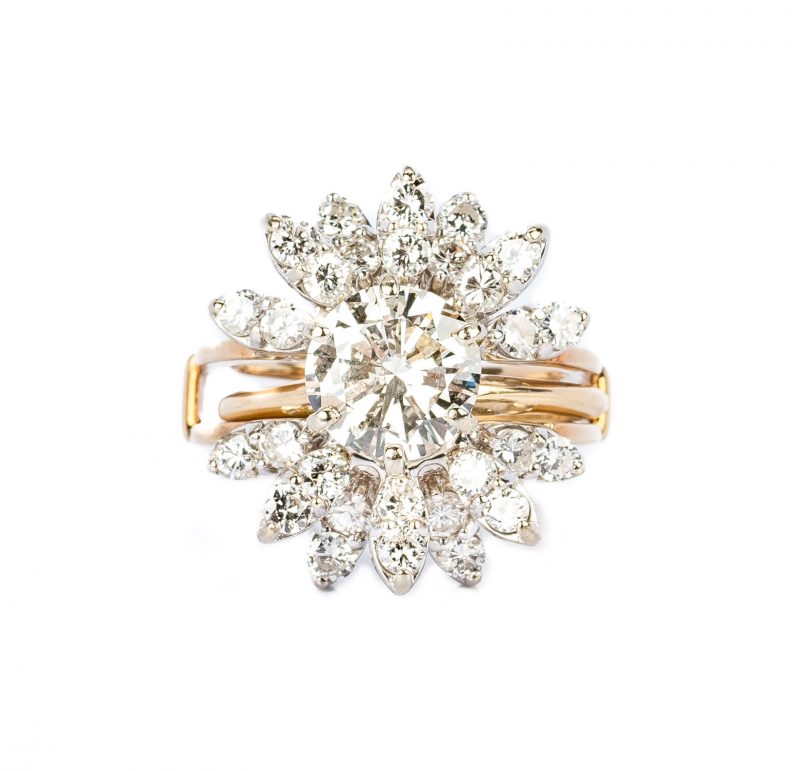 |
|
2.09 ct. round brilliant solitaire diamond ring with 14K diamond jacket. 14K Diamond solitaire weighs 2.09 ct and measures 8.61 x 8.53 x 5.23 mm. Clarity range: SI1-SI2, Color range: J-K, Table: 58%, Depth: 60.9%, Cut & Finish: Good, Symmetry: Good, Culet: Small, Girdle: Thin to very thin, Fluorescence: None. No certificate present. 14K gold and diamond ring jacket containing 28 round brilliant diamonds with total weight of approximately 1.40 cts., VS1-VS2 clarity, F-G color. 6 1/2 ring size. All diamonds set in 14 karat yellow gold mountings with 14K white gold heads. Marked 14K. 9.5 grams total weight/set. |
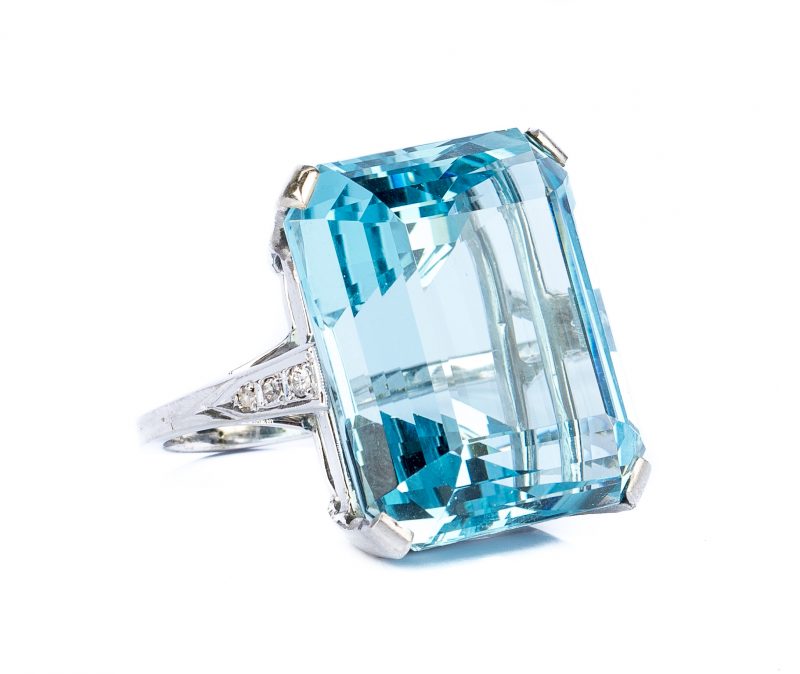 |
|
H. Stern aquamarine, diamond and 14K white gold ring, center emerald-cut aquamarine weighing approximately 44.14 carats by formula, in a 14 karat white gold four prong box setting containing 4 round single cut and 2 round modified brilliant cut diamonds with total weight of approximately .12 ct. GIA report 2195831508, dated November 28, 2018, states aquamarine is Octagonal, Step Cut, Transparent, Blue, Natural Beryl, Aquamarine measuring 22.64 x 20.06 x 14.19 mm. 15.03 grams. Ring size 5 1/2. Provenance: the estate of Martha Dodge, Hendersonville, Tennessee. Purchased at H. Stern in Rio de Janeiro circa 1945 by Dr. Edward Dunlap; by descent to his niece, Martha Dodge. Note: Dunlap was chief of the ophthalmology division of Cornell Medical Center in New York. He was a noted gem and mineral collector who bequeathed his mineral collection to Case Western Reserve University upon his death in 2004. |
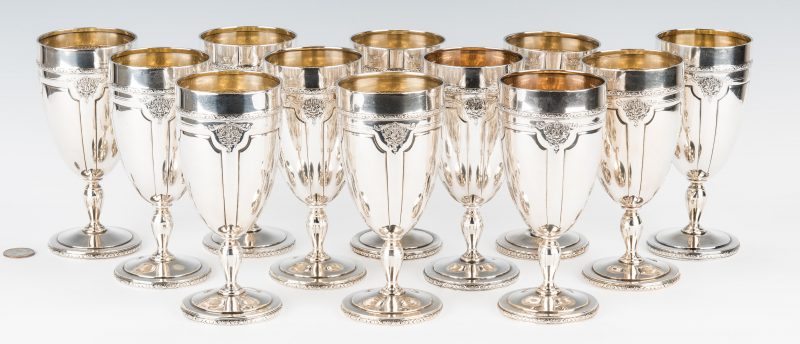 |
|
Set of twelve (12) Towle sterling silver goblets in the Louis XIV pattern, all with gilt wash interiors. 6 1/2″ H. 20th century. 66.08 total troy ounces. |
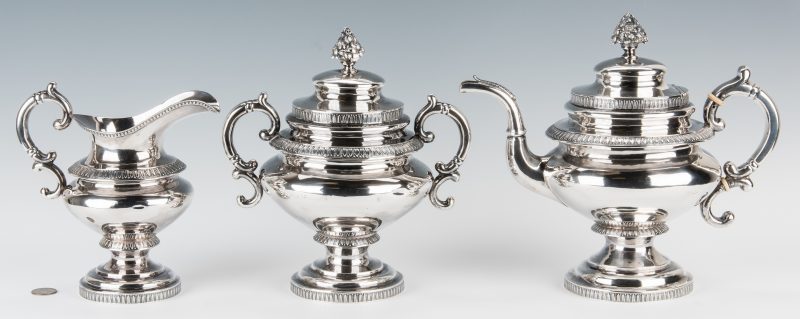 |
|
John Cox and James Cox (New York, working 1817-1852) American coin silver tea service comprised of three (3) pieces including a tea pot, creamer and covered sugar bowl. All pieces are of identical round footed form with bands of acanthus leaf decoration at upper and middle sections and around the bases, teapot and sugar bowl tops with fruit basket finials, and all pieces with c-scroll handles. All marked on the underside “J & I Cox /N York”. Ranging in size from 8″ H x 8″ W to 10 1/2″ H x 12″ W. 83.57 total troy ounces. |
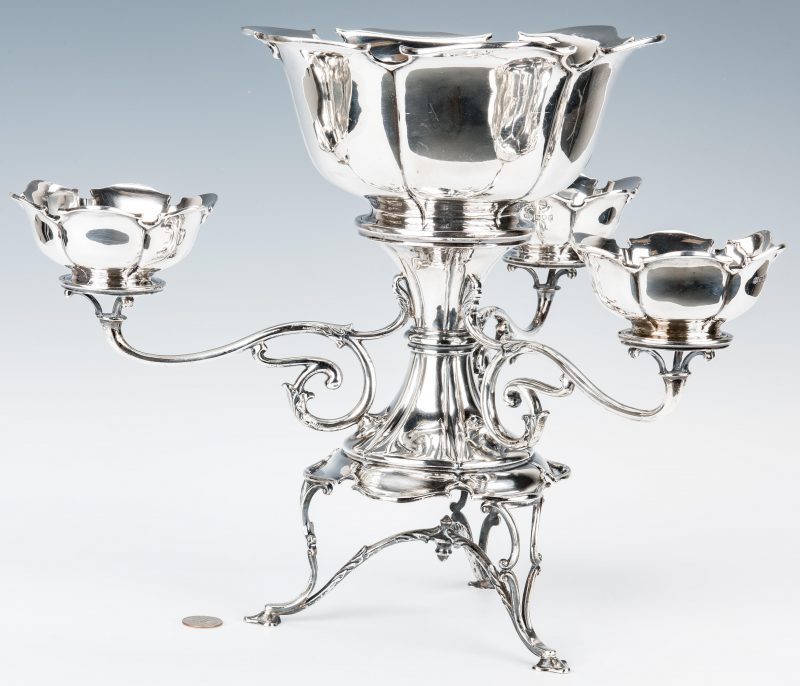 |
|
Hamilton & Company, London, sterling silver epergne or centerpiece. Comprised of one (1) large center bowl atop a central stand with molded base flanked by three (3) smaller bowls supported by scrolling foliate arms, bowls with shaped bodies and molded flaring rims. Stand rests on three pierced foliate legs terminating into pad feet joined by a foliate stretcher with an acorn finial. All bowls with Hamilton & Company hallmark, lion passant and London hallmarks and date mark for 1910. Base with with Hamilton & Company hallmark, lion passant and London hallmarks and date mark for 1910, additionally marked “Hamilton & Company/Calcutta”. Bowls weigh 32.775 troy ounces. Stand weighs 42.360. 75.135 total troy ounces. |
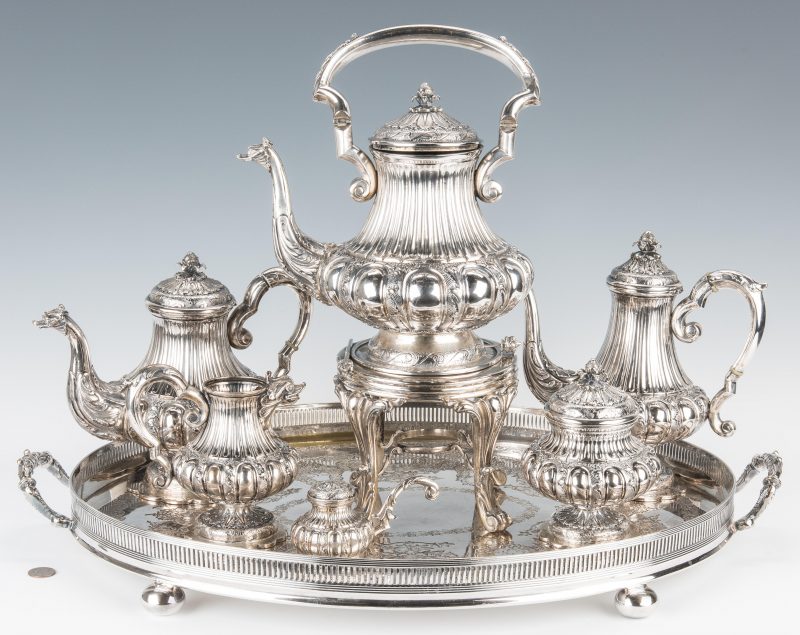 |
|
Continental, possibly Italian, 800 silver tea service consisting of a hot water urn with stand and warmer, coffee pot, tea pot, covered sugar and cream pitcher. Designed with flower shaped finial, acanthus leaf carved and applied lid, fluted, gadrooned and acanthus leaf carved body with dragon spout and acanthus leaf s-scroll handle, all raised on acanthus leaf footed scrolled base. 2-3/4″ to 12-1/2″ H. 201.28 total oz troy/600 silver. Group also includes large oval two-handled footed gallery tray with scroll and shell decorated surface, no maker’s mark. 3″ H x 24-1/2″ W plus 2-1/4″ D handles x 18-1/2″D. |
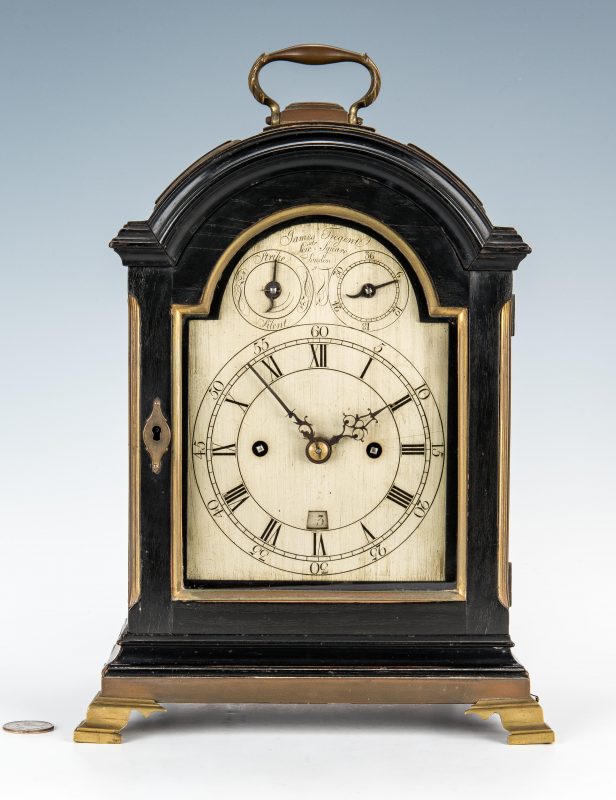 |
|
James Tregent (British, Active 1770-1806) George III Bracket Clock from the estate of noted architect Clarence Mack. Clock with brass eight-day movement and bell chime, ebonized mahogany case with arched and paneled top, each mahogany panel raised on a brass plinth; the center one with brass bail handle. Tombstone-arch glass doors to front and back and arched windows to sides, all with brass rabbet edges, the back glass revealing ornate engraved decoration to movement back; all on brass base raised on brass ogee feet. Metal dial engraved “James Tregent / Leicest’r Square / London”, engraved chapter ring with Roman numerals and Arabic minutes numerals and date aperture, surmounted by chime/silent selector dial. Pendulum present. Circa 1780. Keys included along with a 20th century list of dates the clock was cleaned, ranging from 1785-1985. 13″h x 9″W x 6 3/4″D. |
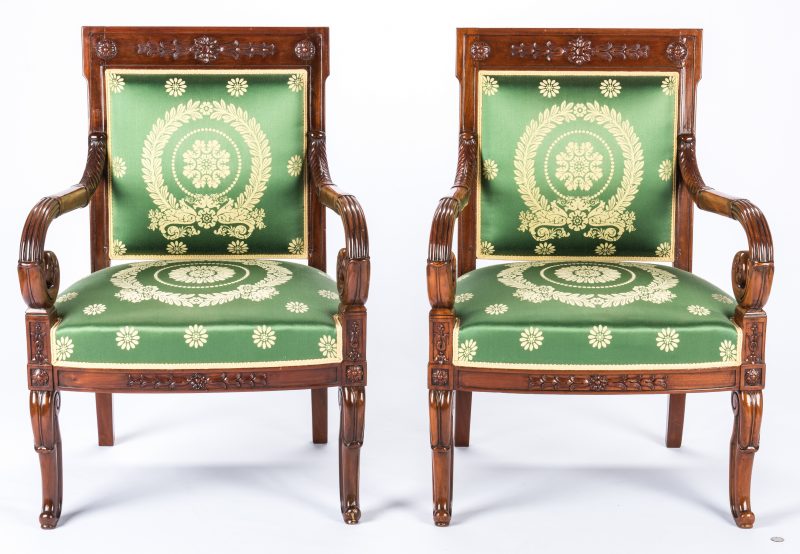 |
|
Pair of Neoclassical mahogany arm chairs or fauteuils, stamped COUDURIER on the underside of each seat rail, mahogany with beech secondary wood, having square upholstered backs with husk and rosette carved crest rail, leaf-carved arms with reeded and scrolling supports terminating in carved rosettes; trapezoidal upholstered seat with husk and rosette carved seat rail and scroll-carved cabriole front legs. Recent Neoclassical style green and gold upholstery with laurel wreath and rosette motifs. 36″ H x 25 3/4″ W x 22″ D. Circa 1815-1820. Provenance: Private Nashville, Tennessee collection, ex-Hirschl & Adler Galleries, New York. Hirschl & Adler’s description of the chairs notes that while “no indication of a maker named Coudrurier appears in records known to date, the design for this pair of French armchairs seems to have been taken directly from Plate 53 (1805-08) of Pierre de la Mesangere’s “Collection des Meubles et Objets de Gout” which appeared serially in Paris from 1796 to 1830 (reprint, ed. A Calavas, Paris Librairie des Arts Decoratifs, undated). Interestingly, while the joint between the scrolled arms and the stiles for the front legs as well as the front legs themselves in this pair differ completely from Mesangere, they are virtually identical to those on a chair made in Philadelphia about 1820.” |
|
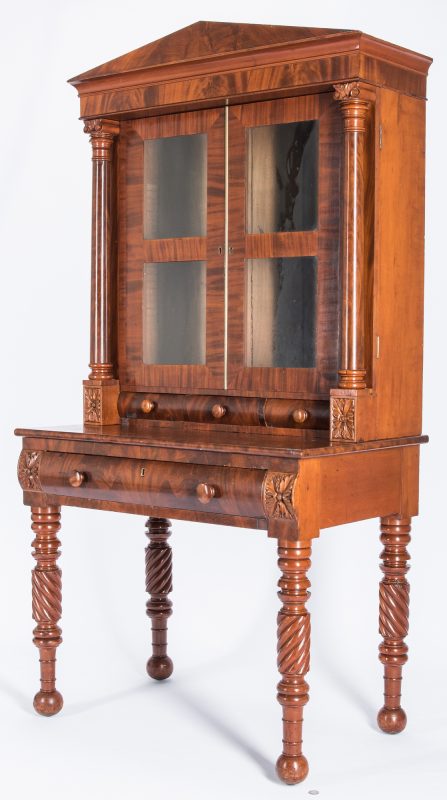 |
|
Diminutive Classical Kentucky secretary bookcase, figured mahogany veneers and cherry primary, pine and poplar secondary. Two part construction, pediment cornice over two paneled glass doors with brass edge, flanked by fully carved Ionic columns with acanthus carved plinths, over three dovetailed drawers. Base with one full convex-front drawer, flanked by carved acanthus medallions, and containing a fold-out hinged baize covered writing surface with two storage compartments, above four bold ring and rope twist turned legs terminating in ball feet. 73 1/2″ H x 37 1/4″ W. 23 1/4″ D. Circa 1830. Note: A similar example that descended in the Rowan Family of Bardstown is currently in the collection of Federal Hill, My Old Kentucky Home (ref. “Collecting Kentucky, 1790-1860” p. 293 by Genevieve Baird Lacer and Libby Turner Howard). |
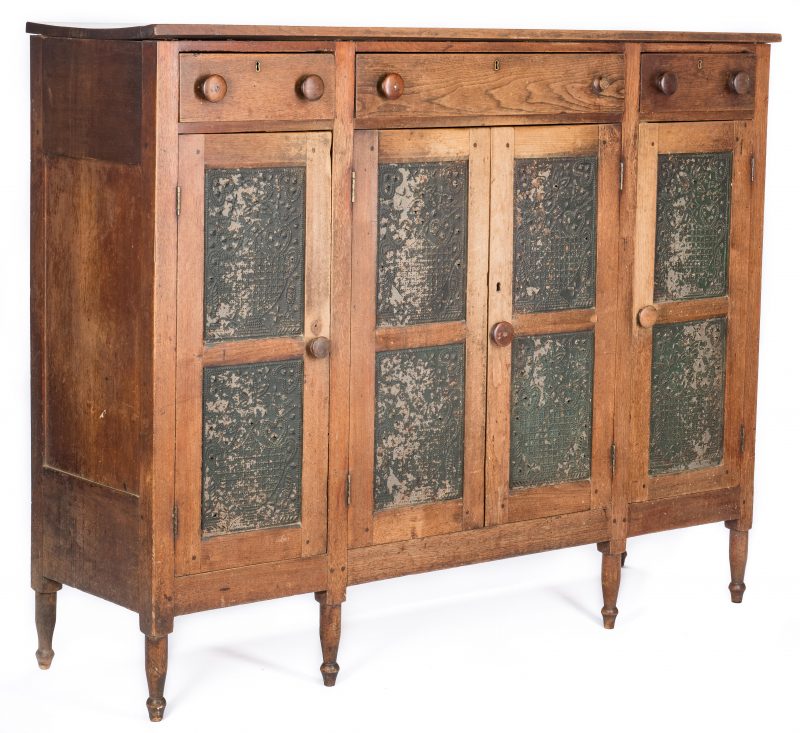 |
|
Southwest Virginia Sheraton form sideboard pie safe, walnut primary and poplar secondary. Comprised of an overhanging top over three dovetailed drawers, four paneled inset doors with painted pie safe tins having finely punched urn, flower and star decoration, interior fitted with two shelves, paneled sides, all over turned legs. 51 1/8″ H x 65 1/4″ W x 18 1/2″ D. 3rd Qtr. 19th century. |
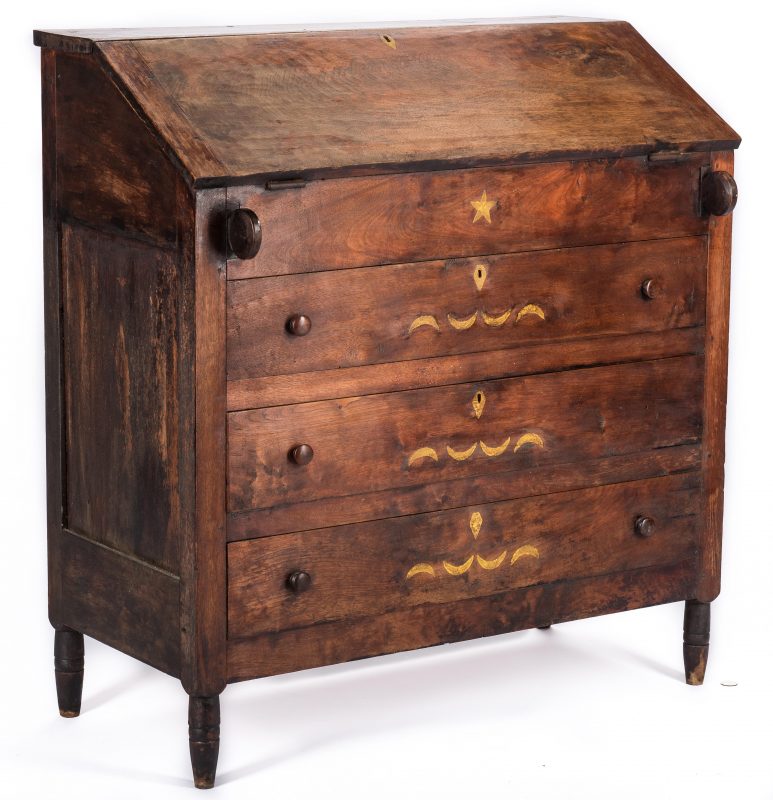 |
|
East Tennessee child’s desk, walnut primary with poplar and yellow pine secondary. Comprised of a slant front lid, lopers with “lollypop” circular ends, plain interior, hidden shelf below the desk interior, three full length drawers with wood knobs, turned Sheraton feet. Square nail construction throughout. Yellow stencil painted star, diamond and crescent moon decoration to the drawer fronts. 36″ H x 34″ W x 15 1/2″ D. Found in the Boozy Creek area of Sullivan County, TN. Third quarter of the 19th century. |
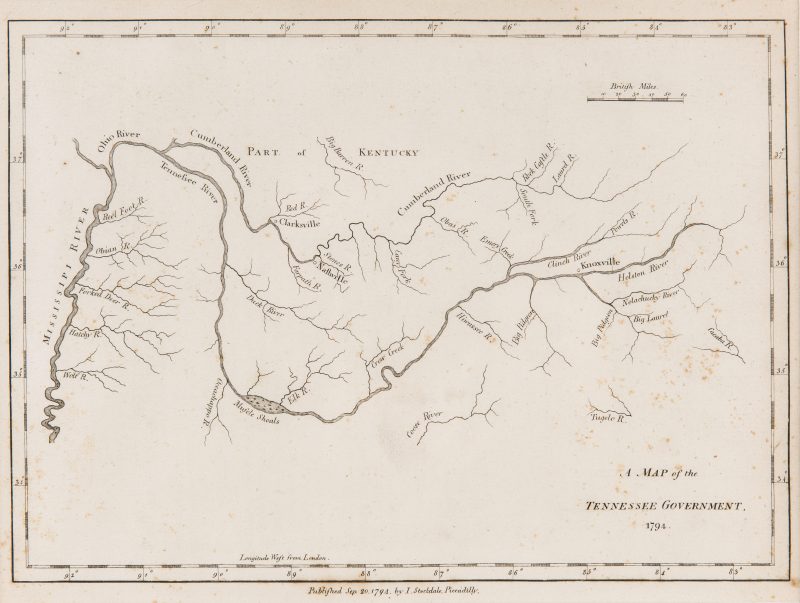 |
|
18th century Tennessee Map, published by Stockdale of Picadilly, entitled “A Map of the Tennessee Government, 1794.” Engraving showing the Tennessee and Cumberland Rivers and giving the locations of Clarksville, Nashville, and Knoxville. One of the earliest Tennessee maps. |
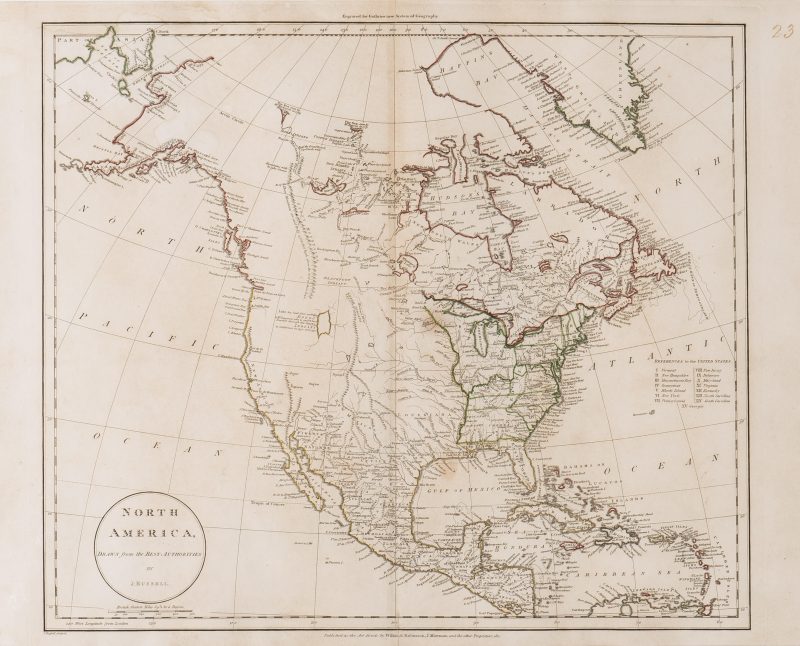 |
|
“North America, Drawn from the Best Authorities” engraved by John Russell, published by Wilkie, Robinson, J. Mawman, London, 1811. From “New System of Modern Geography” by William Guthrie. Copper plate engraving with hand coloring depicting America, with parts of Canada, including incomplete parts of the Arctic Circle, Mexico, Central America, and the Caribbean with cities and towns, roads, rivers, bodies of water, and other areas of interest including the locations of Native Americans such as the large lake illustrated in the lands of the Doegg Indians and was “laid down according to Mr. Lawrence, who is said to have Travell’d through this Country to California in 1790 and 1791”, the “Slave Lake” to the right of the Stony Mountains and the “Mountains with bright Stones” predating the joining of the Rocky Mountains into one continuous chain. Title and scale of miles, lower left, References, center right. Map surrounded by scale notations and a double line border. Image – 15 1/4″ H x 17 3/4″ W. Plate – 16 1/8″ H x 18 5/8″ W. Framed – 25 1/4″ H x 27 1/4″ W. |
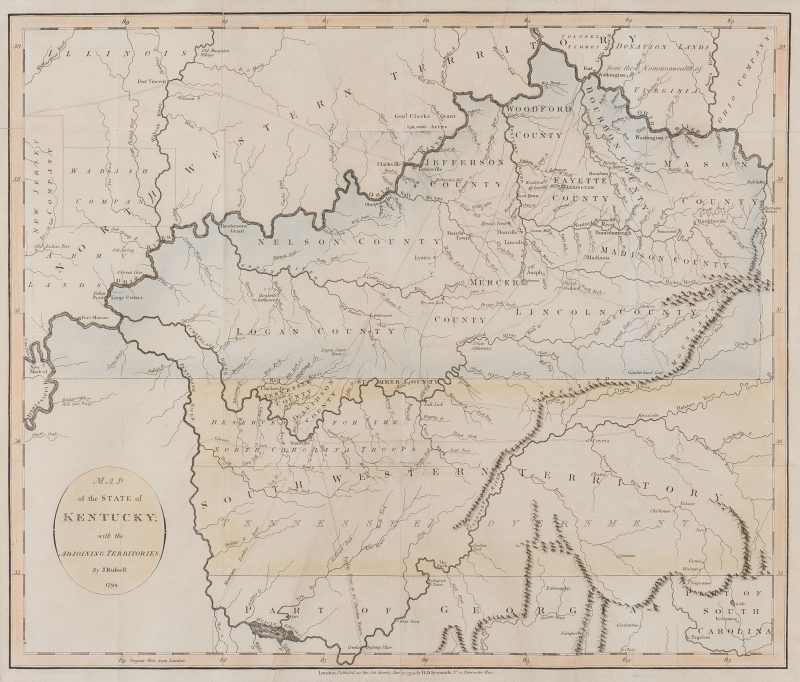 |
|
A MAP OF THE STATE OF KENTUCKY WITH THE ADJOINING TERRITORIES by J. Russell, 1794. London: H.D. Symonds. Also known as the earliest reliable map of Tennessee, the majority of which is labeled the “Southwestern Territory- Tennessee Government”. “Tennessee County” and “Davidson County” are named, as is “Summer (Sumner) County,” and Knoxville. North of the Ohio River is part of the Northwest Territory, with Fort Washington shown. The area south of Tennessee and Davidson Counties, is “Reserved for the North Carolina Troops,” land grants for Revolutionary War service. Part of Georgia and South Carolina also shown. The Kentucky area is shown divided into ten counties: Woodford, Bourbon, Jefferson, Fayette, Mason, Madison, Mercer, Lincoln, Nelson and Logan Counties. J. Whatman 1794 watermark upper left, light hand coloring. Scarce. Image – 15″ H x 17 3/4″ W. Sheet – 16 1/4″ x 18 7/8″, mat 19 7/8″ x 24″. |
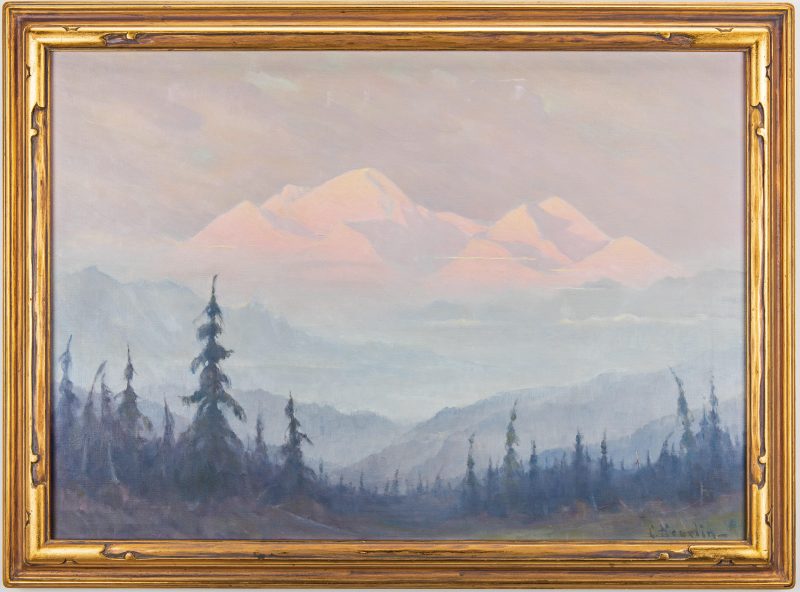 |
|
Magnus Colcord Heurlin (Alaska/Sweden, 1895-1986) oil on canvas mountain landscape depicting Mount McKinley. Signed lower right and housed in the original carved gilt frame. Sight – 24″ H x 33″ W. Framed – 28 3/4″ H x 38 1/2″ W. 20th century. Biography: Heurlin was a Swedish-American artist best known for his pastel palette, luminous skies and Alaskan landscape paintings. Born in Sweden, Heurlin came to Alaska in 1916, first to Valdez and later to Barrow where he lived and painted the Inupiaq. He joined the U.S. Navy in 1917 during World War I, serving in France. After the war, Heurlin moved to Connecticut, where he worked as an illustrator. In the 1930’s he was selected as an artist for the WPA Arts Project in Westport’s public school buildings. He returned to Alaska around 1935 and worked on the gold dredges near Ester for the Fairbanks Exploration (FE) Company. Heurlin taught the first art classes at the University of Alaska Fairbanks in the 1950s, and received an honorary doctorate from the university in 1971. |
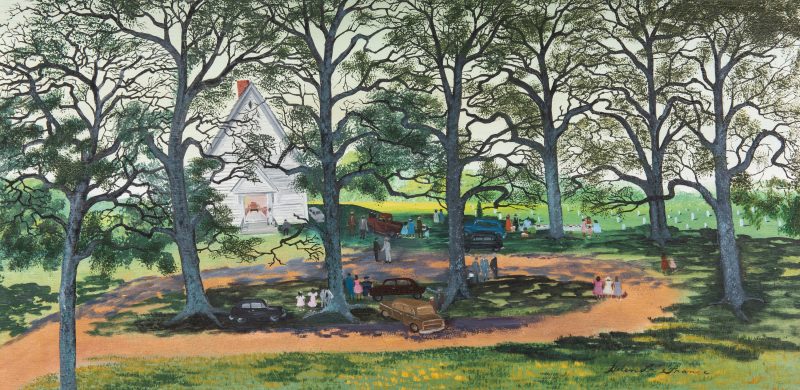 |
|
Helen LaFrance (Kentucky, b. 1919) oil on panel painting depicting an African-American congregation outside of a church, sheltered behind several large trees. Signed lower right. Housed in a gilt and black painted wooden frame with linen rabbet edge. Sight – 15 3/4″ H x 32″ W. Framed – 20 3/4″ H x 37 1/4″ W. American, late 20th century. Provenance: Private Nashville Collection. Biography: Self-taught African American artist Helen LaFrance was born on a Kentucky farm and began painting in her 40s. She is known for her “memory paintings” – drawn from her recollections of life growing up in the rural South. Several museums and private collectors, including Oprah Winfrey, own examples of her work. Now nearly 100 years old, she resides in a Kentucky nursing home. (source: “Helen LaFrance Folk Art Memories” by Kathy Moses). Alternate spelling: Helen La France. |
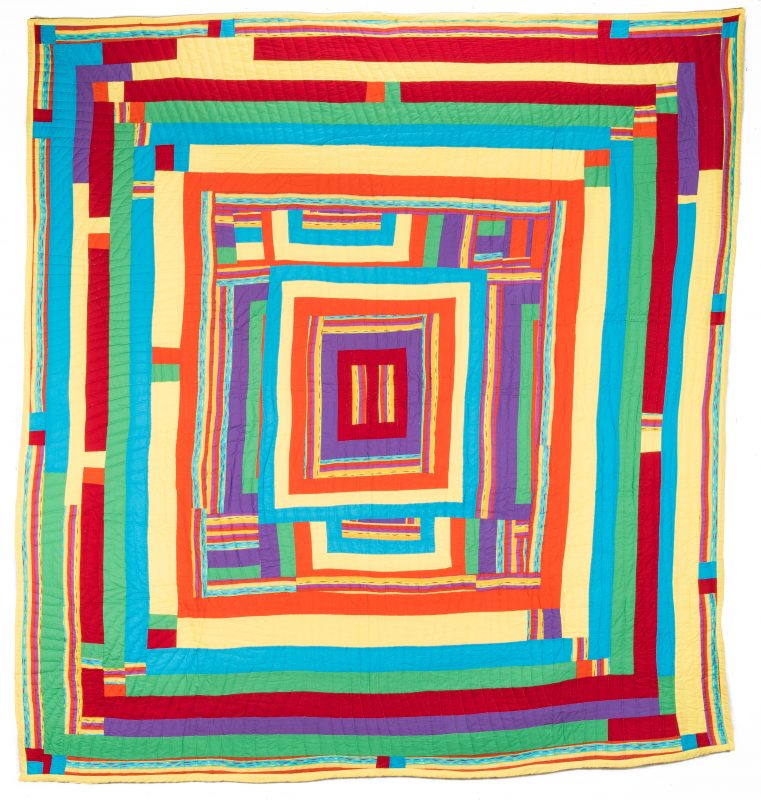 |
|
Gee’s Bend Alabama pieced quilt by Bettie Bendolph Seltzer (1939 – 2017), house-top pattern variation stitched in bright colors including yellow, red, purple, aqua and green. Signed en verso to one corner “Bettie B. Seltzer” and additionally stamped “Gee’s Bend Quilters Collective”. 86 1/4″ x 84 1/2″. 20th century. |
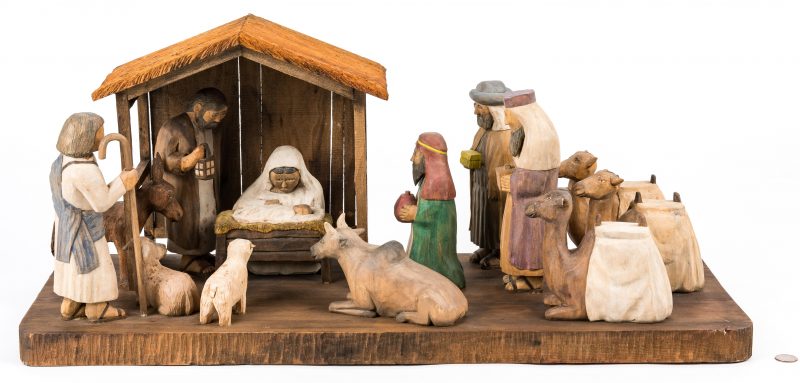 |
|
Roy Pace (Tennessee, d. 2011) hand carved and painted Nativity Set depicting the Holy Family in a manger, surrounded by three wisemen, a shepherd, and animals including camels, cow, donkey and sheep. All figures are attached to a wooden base. Signed and dated “Roy Pace 1989″ at rear of base. 13 1/2″H x 31″W x 12 1/2” D. Note: Pace made Nativity sets with attached figures for only one year; subsequent sets featured separate figures. All are scarce. |
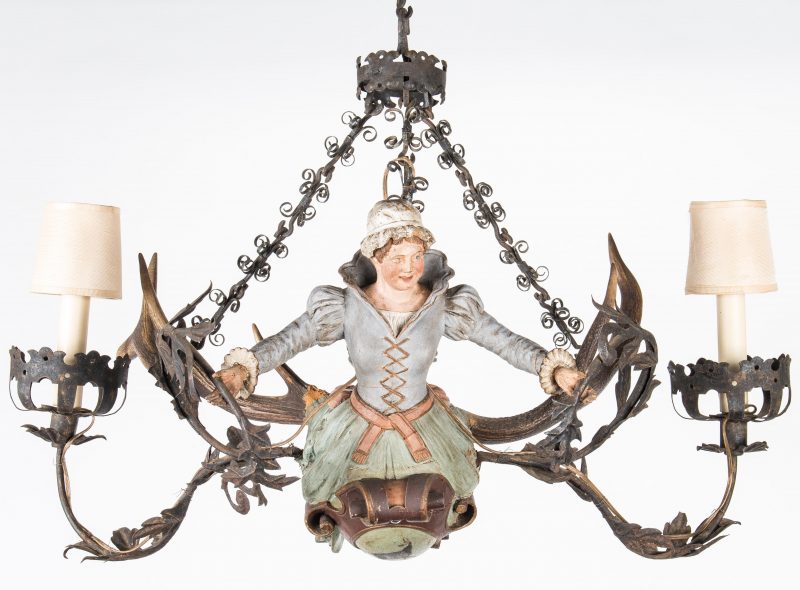 |
|
Black Forest Lusterweibchen carved and polychrome painted mermaid chandelier with antlers. Circa 1900. |
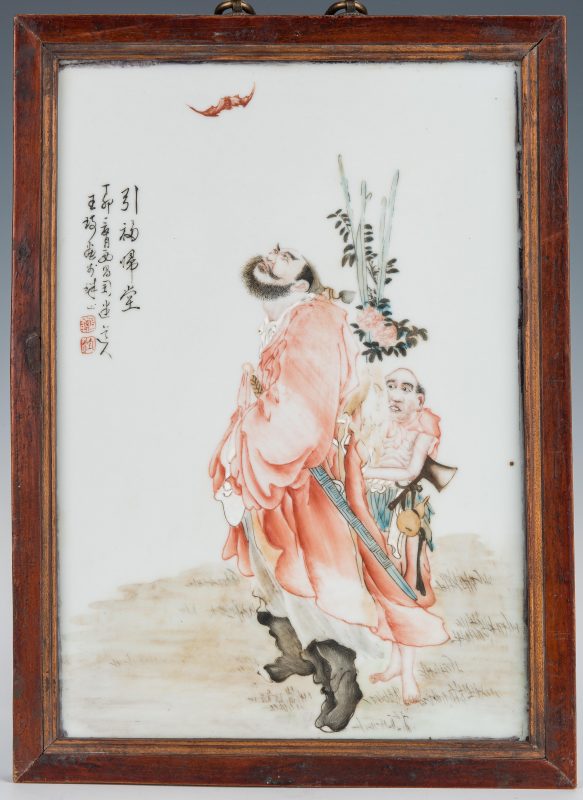 |
|
Republic Period Chinese Famille Rose porcelain plaque depicting an Immortal and attendant gazing upwards at a bat. Chinese inscription upper left reading in part “Bringing blessings to the room/house” along with the signature of Wang Qi, the Ding Mao (Sexagenary Cycle) date of 1927 and two red seals. Framed in a hardwood frame with gilt liner and Chinese brass hardware. Sight – 13 7/8″ H x 9 1/2″ W. Framed – 15 3/4″ H x 11 1/2″ W. |
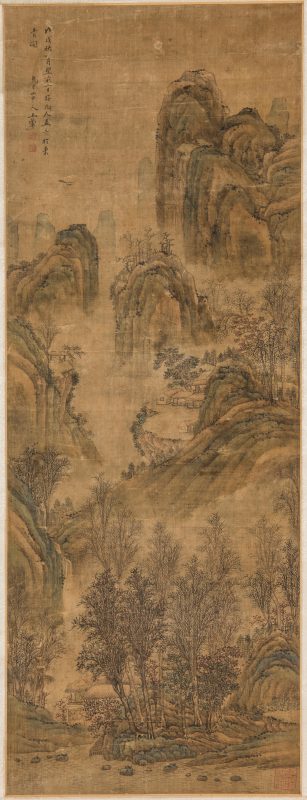 |
|
After Sheng Mou (Chinese, active ca. 1310-1360) landscape painting, ink and color on silk, depicting a house beside a river, surrounded by trees, at the base of a mountain with cascading waterfalls. Signature of Wang Hui (Chinese, 1632-1717), seal and inscription at top left, additional seal mark lower right. Inscription translated as: “1658, 8th month, 2nd day, in the manner of Sheng Mou of the Yuan Dynasty at Dongqing ge (East Green Hall). The Man of Wumu Mountain, Wang Hui”. Scroll: 64 1/2″H x 18 1/2″W, Painting: 39 1/2″H x 14 3/4″W. |
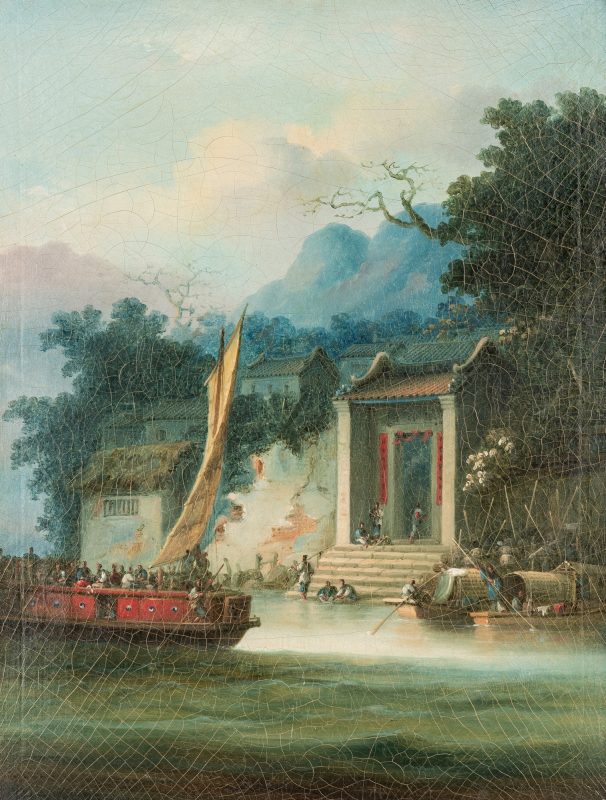 |
|
Chinese School painting, manner of George Chinnery, possibly intended for export. Oil on canvas landscape depicting a boat filled with people approaching the entrance to a walled city, with various figures at the steps to the entrance and red banners adorning the portal. Smaller boats are visible in the foreground, and trees, mountains and other buildings rise in the background. 20th century label en verso reads “1548 Oriental Harbor Scene”. Housed in an ebonized Chinese style molded frame with curved and notched corners and brass fret holders. Sight – 20 1/4″ H x 15 1/2″ W. Framed – 22 1/4″ H x 17 1/2″ W. Likely late 18th to early 19th century. Provenance: the estate of Delle Brown, Nashville, TN. Delle Brown and her late husband Malvern Brown were, for many years, the proprietors of Trace Tavern Antiques. |
 |
|
Chinese celadon jade relief carved Ruyi Scepter, large Lingzhi carved top and carved flowering branch handle with peach, bat and smaller Lingzhi decoration. 10 1/2″ L x 3″ W. Late 19th/Early 20th century. |
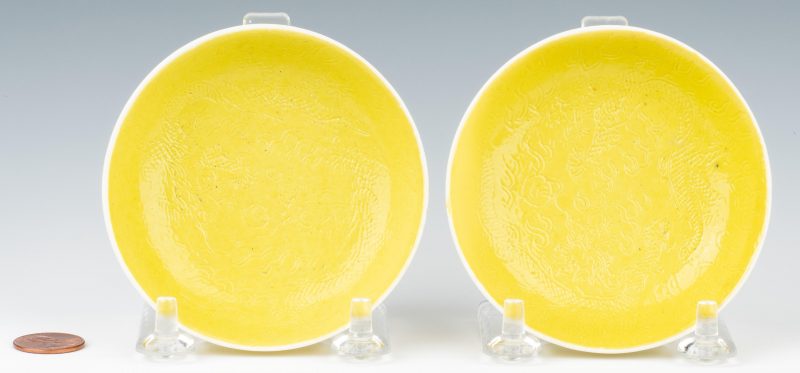 |
|
Pair of Chinese Imperial Lime Yellow Glaze Saucer Dishes, round with incised decoration of writing five toed dragons in clouds, Guangxu mark and period (1875-1909). Labels for Vermeer & Griggs Asian Art on undersides. 3 3/8″ diameter. |
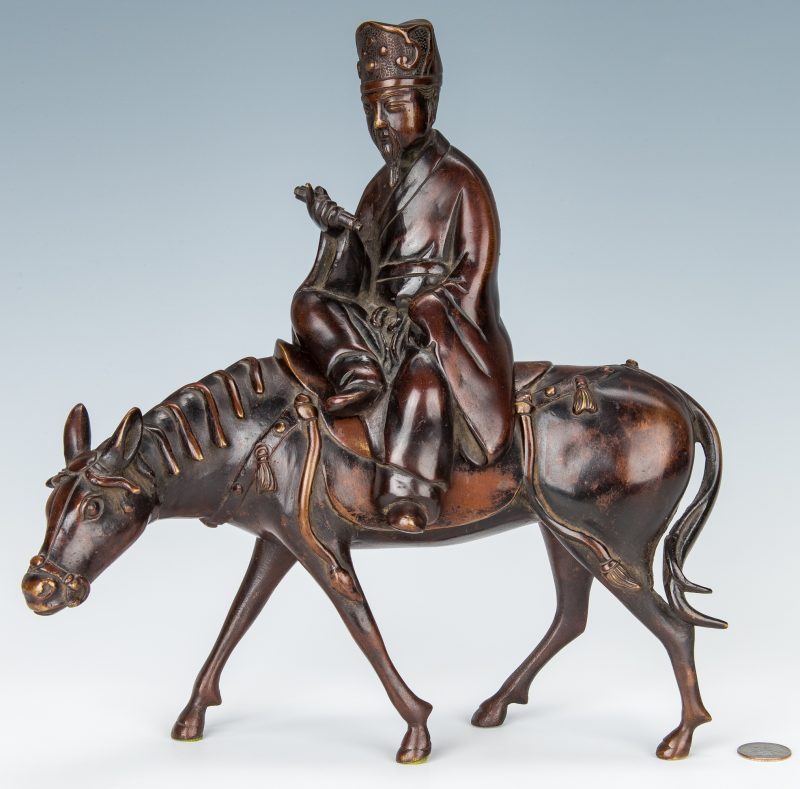 |
|
Chinese bronze two-piece incense burner consisting of a horse with scholar atop his back. Horse is modeled standing and fitted with bridle and saddle. The rider wearing a robe and decorated hat, sits atop sideways, with raised right arm and pointed index finger and holds a scroll. Unmarked. 12 3/4″ H x 12″ L x 4 1/4″ D. Qing dynasty. Note: Acquired by the consignor’s father during his travels in the Far East in the 1950’s. |
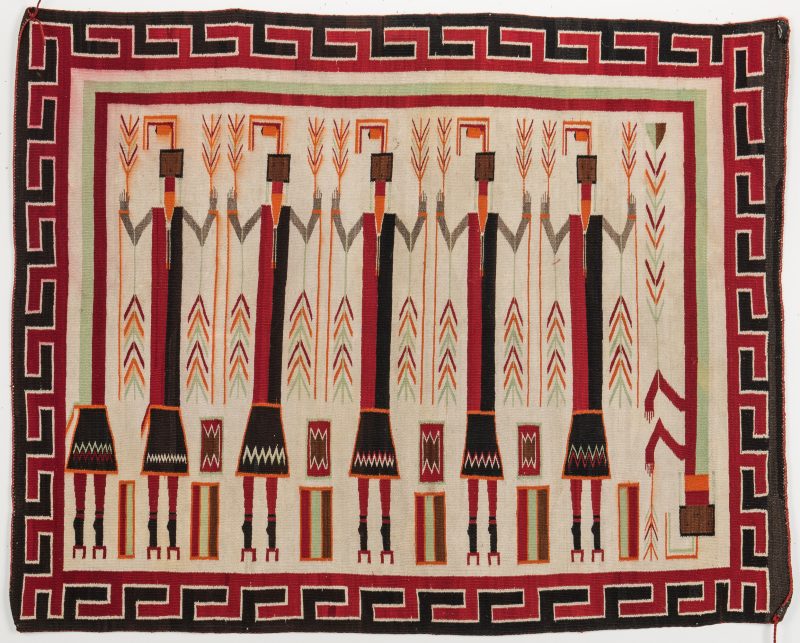 |
|
Navajo Yei area wool rug weaving, 53″ x 42 1/2″, depicting five standing spirit figures, each holding cornstalks, enclosed by alternating rainbow goddess and outside key border, colors of red, brown, orange, green and taupe. Circa 1920. |
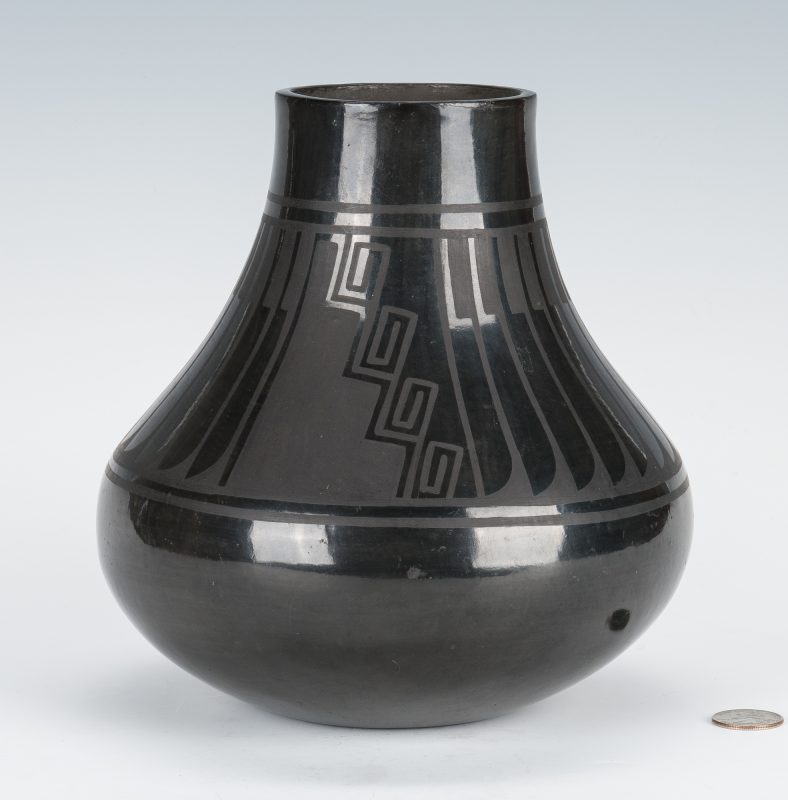 |
|
Large Native American San Ildefonso black on black pottery jar by Crucita Gonzales Calabaza (1921-1999) with stylized feather and geometric designs to the body. Signed on the base “Blue Corn/San Ildefonso Pueblo”. 8 1/4″ H x 8″ dia. 20th century. Provenance: Brad Swanson Collection, Abingdon, VA. |
 |
|
Bert Stern (American, 1929-2013) limited edition black and white unframed pigment print for Vogue of Marilyn Monroe titled “Marilyn in Vogue” depicting Monroe in black dress in a pensive pose, from the 1962 Last Sitting Series. Numbered 9/72 and signed lower margin by Monroe and Stern in white pencil. Additionally signed and stamped by Stern and dated 2009 en verso. Includes Bert Stern certificate of authenticity. 19″H x 13″W. |
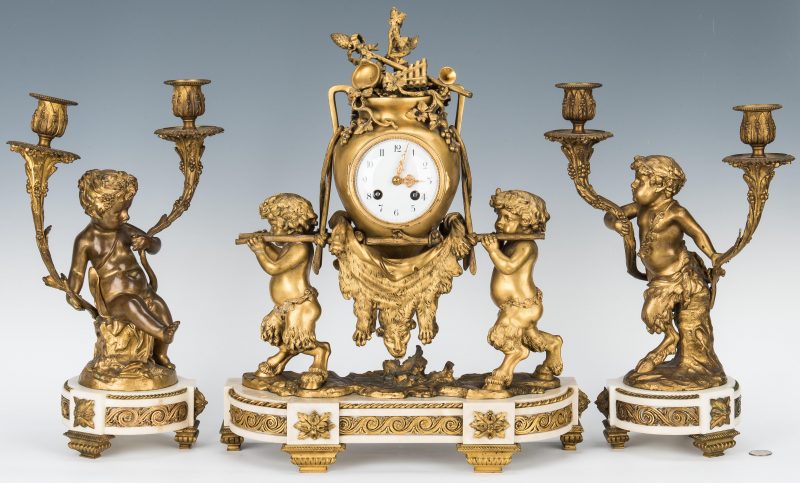 |
|
French Louis XV style ormolu and marble three piece clock and garniture set; marble bases mounted with gilt bronze cherub figures supporting candelabra signed “Clodion” and 19th century clock adorned with hunting themed decorations, including a figural bronze bear pelt. Clock face with enameled porcelain dial and gilt filigree hands, unsigned; base mounted with applied rosettes and inset bronze guilloche ornament. Candelabra – 15 1/2″ x 11″ x 6″ dia. (at base). Clock – 19″ H x 15″ W x 6″ D. |































































































